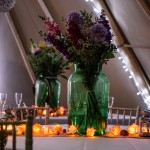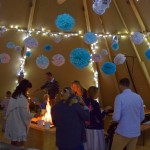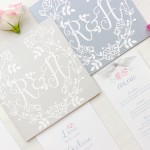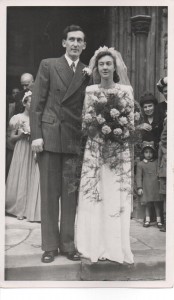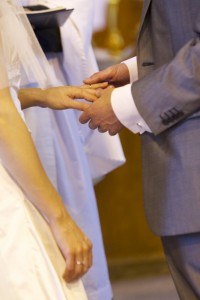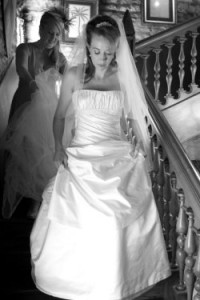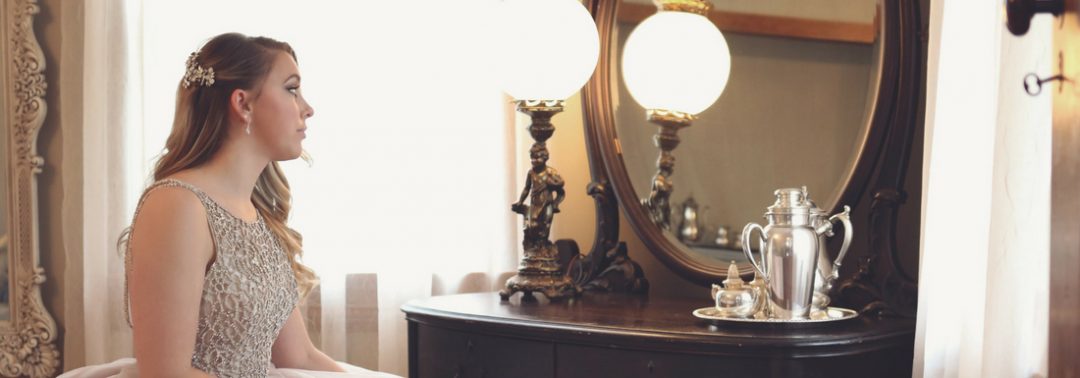
by Hanami Dream | 5, July, 2018 | blog, guest post, tips
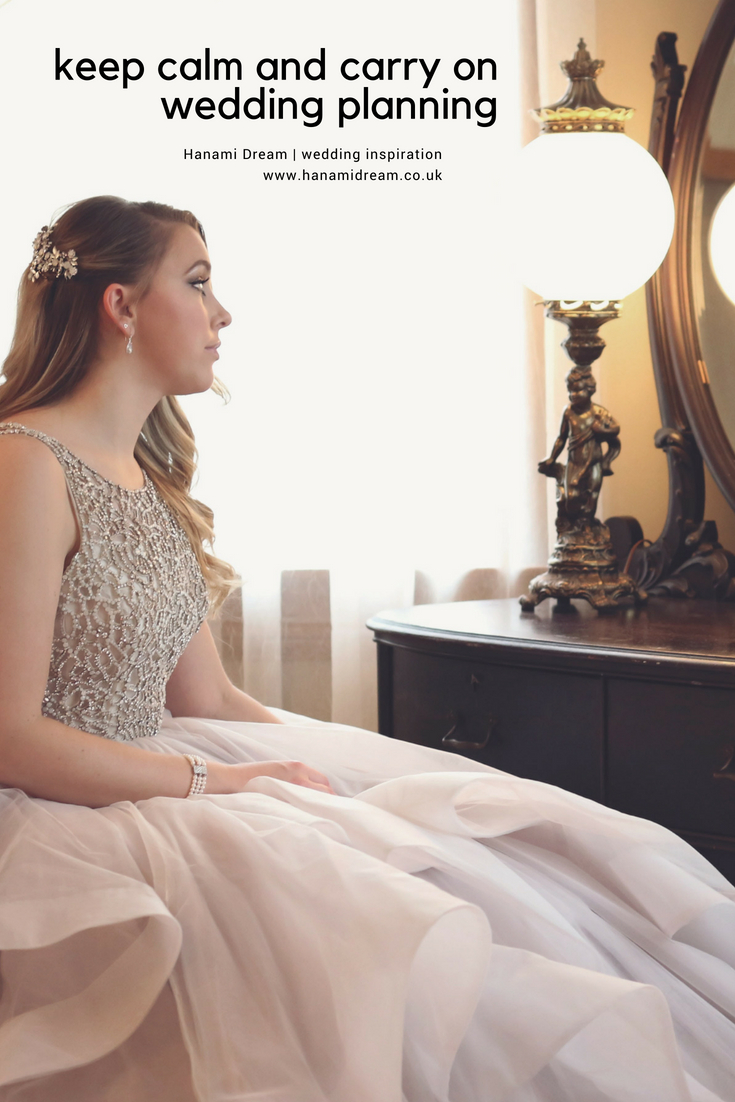
Keep calm and carry on…wedding planning
Huge congratulations if you’re currently planning your forthcoming wedding. Whilst organising a wedding is incredibly exciting, it can sometimes be a daunting challenge too. Especially as you’ve possibly never organised an event of this scale or importance before, you’re trying to please lots of people and everyone seems to have an opinion on it. So it would be understandable if you find that you can’t keep calm and are sometimes stressing over the small stuff.
Here are top tips from Stephanie Varda Bridal Coach on staying calm and dealing with stress during the wedding planning process and build up. Considering how to deal with conflict, compromise and comments from other parties.
 Ten things to remember when (not if!) you get stressed while planning your wedding
Ten things to remember when (not if!) you get stressed while planning your wedding
- Get some perspective
This is the first tip because it kind of shocks some brides. So many people think their wedding day is the most important day of their lives. Your wedding day is the first day of your marriage, so it’s worth keeping that in mind. Your marriage and your partner will be very important to you as you go through life. Remember what this is really about. Now for the practical stuff….
- Do it together
That’s what marriage is about – so don’t take responsibility for all the decision making involved in planning your wedding. Discuss things as a couple – talk to your partner about what you both want from your wedding.
- Delegate
Even better than planning together could be to ask your partner what they would like to take charge of and let them own that part of the wedding.
- Get help
If friends and family offer help, then accept it. As discussed above, you could either delegate some smaller tasks to them (or the tasks you don’t like so much!) or accept their advice where you need it. Beware of unsolicited interference that presents itself as help or advice, though – say no to that!
- Be grateful
Your loved ones will be spending lots of time, money and effort on your special day. They might not agree with all of your choices, but they are doing this how you want it because they love you. So, appreciate them.
- Take breaks
Don’t live and breathe your wedding for the entire time you are planning. You will just start to resent it all. Take time out to do something else for a little while, perhaps with your bridesmaids or your other half.
- Adapt
Things might not go exactly to plan, and plans may change. Don’t get upset about things that you can’t do anything about, and stay flexible and open to change. A wedding involves lots of people, and some of them won’t do exactly as you want them to.
- Prioritise
Decide which parts of the day are most important to you and where you want to splurge, and which you don’t care so much about and those might be where you can save a little on costs. This will help you to…
- Don’t sweat the small stuff
Identify what is not that important and either delegate or just get it done and don’t think about it again. Think about the whole day and the bigger picture of what you want from your wedding. Don’t get caught up in worrying about the details – nobody will notice anyway, your guests will just want to enjoy the day, have a big party and celebrate your love.
- This is your day
This one is last because this is the one you really need to remember. This should be your mantra. We all want our guests to have a great time on our wedding day, but you can never please all of the people all of the time and this is your day, so do it your way!

 @svardalifecoach
@svardalifecoach

 @stephanievardalifecoach
@stephanievardalifecoach
 @lifecoachingstephanie
@lifecoachingstephanie
Sign up to receive the latest wedding planning tips, tools, trends and traditions straight to your inbox.
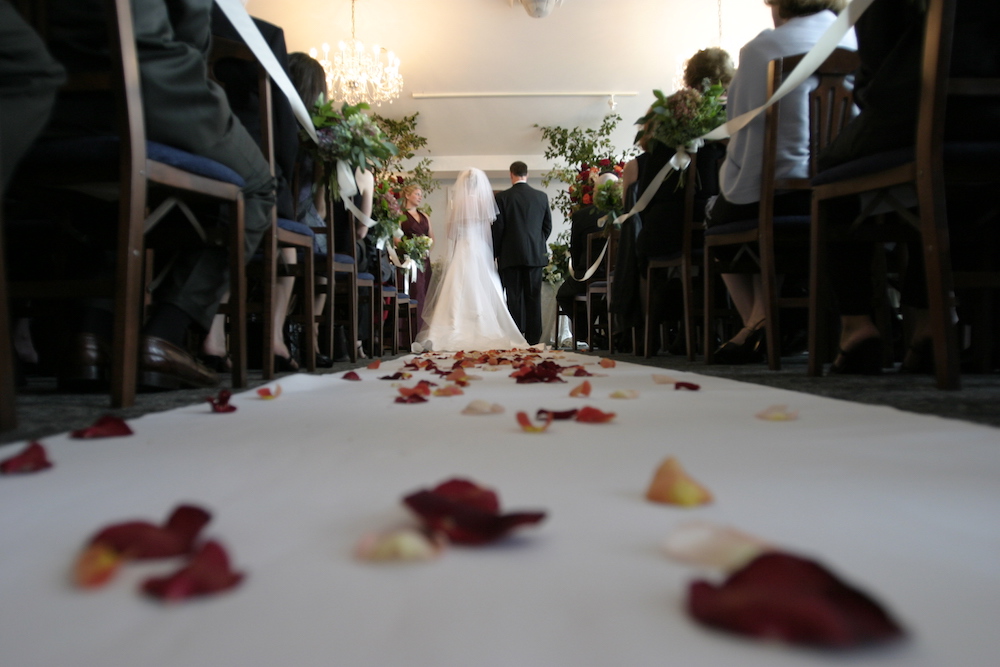
by Hanami Dream | 12, June, 2018 | blog, guest post, tips
Why you should take out wedding insurance
Here are some insights from the Wedding Insurance Group – they discuss what wedding insurance is, what it covers, how much it costs as well as some tips on selecting the best wedding insurance policy and what are the risks of an uninsured wedding.
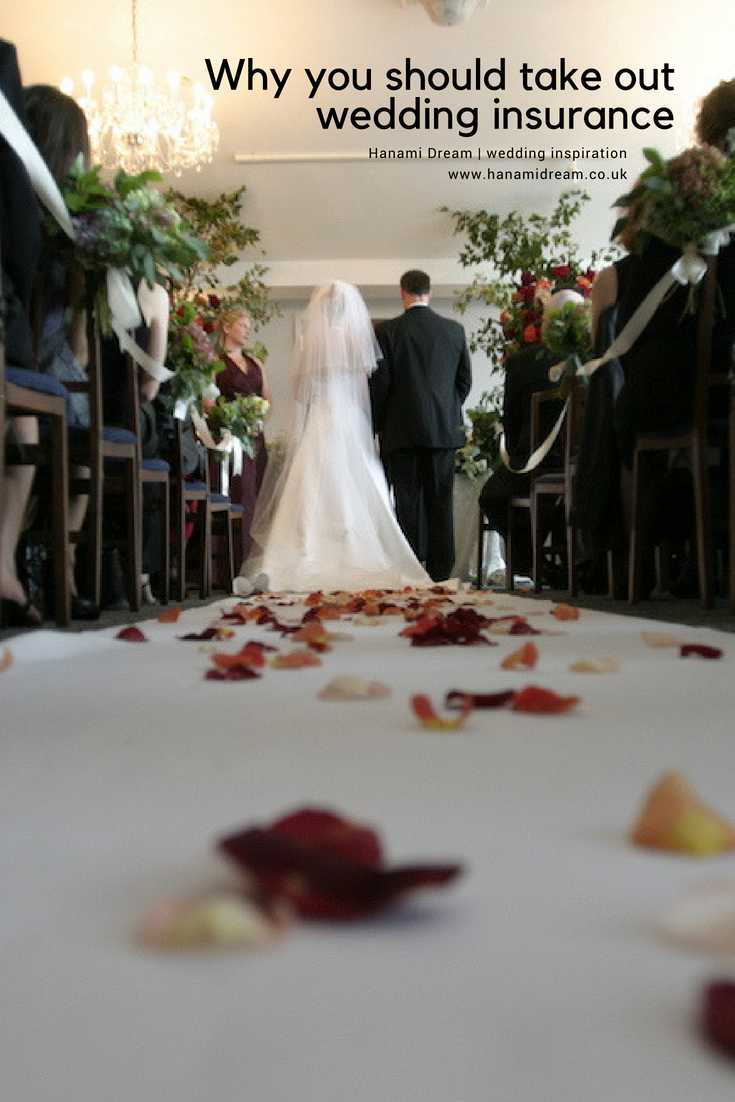
The majority of couples will tie the knot this year without wedding insurance. The last time a study was conducted in 2010, Datamonitor estimated 3 out of 4 weddings in the UK go-ahead uninsured. We don’t have any recent national data, however, our friends over at the Wedding Insurance Group have reported an increase in the number of couples taking out wedding insurance in the last year. It is still arguable that the majority of wedding days and receptions go on uninsured. To understand more, we first have to look at how much weddings cost on average.
The average cost of a UK wedding
It’s no secret that the average cost of a UK wedding has increased over the years. In 2017, various sources reported different averages:
• £27,161 – Hitched
• £30,111 – Brides Magazine
• £17,000 to £27,000 – Bridebook
It’s understandable that many couples will be aiming for a cheaper wedding but at the end of the day, weddings usually are expensive and therefore may require insurance for the couple’s peace of mind. Here’s a scenario to put this in perspective.
Insure your wedding just like your other life assets
Imagine you bought an expensive piece of jewellery that was not covered by your contents insurance. Would you be comfortable leaving your property knowing that if something went wrong, you would not be able to recover its value? Chances are, you’ll ensure that such an asset is appropriately insured, just like your car and property. So why should a wedding be any different?
What does wedding insurance cover?
A good policy will protect your wedding ceremony and reception. Many top providers offer different levels of cover as packages. In this article, we will be using the various packages provided by the Wedding Insurance Group as examples. The following key covers are typical of a wedding insurance policy, however you should always read the Policy Wording to ensure the cover meets your needs.

Wedding cancellation
This protects irrecoverable deposits or fees paid up front if the wedding reception or ceremony was unavoidably cancelled due to reasons such as family or the couple falling unexpectedly ill, the venue experiencing a disaster such as fire or flood or the inability of the couple and majority of the guests to reach the wedding ceremony or reception due to adverse weather conditions.
Additional costs of rearrangement
Imagine the couple paid £5,000 for a wedding venue, which then experiences a disaster such as a fire or flood. As a result, the wedding is moved to an alternative venue that costs £2,000 more. The cancellation cover protects the initial £5,000 cost whilst the additional cost of rearrangement cover protects the extra £2,000 to move the wedding in the event of a valid claim.
The financial failure of suppliers
This provides cover if suppliers have gone out of business due to bankruptcy or liquidation. For example, the cake maker or photographer end up closing their business and are unable to deliver their services. Irrecoverable deposits and the additional costs of arranging alternative suppliers are covered even if the deposit was paid before you bought the policy. Certain wedding insurance policies also contain a specific cover for wedding cars and transport in the instance of breakdowns or accidents.
Additional covers
The policies provided by the Wedding Insurance Group also cover additional important aspects of the wedding such as:
- Wedding gifts
- Rings
- Flowers
- Wedding cake
- Attendants gifts
Wedding liability insurance
This is essentially public liability for the couple that covers accidental injury to third parties or accidental loss of or accidental damage to third party property. Certain policies such as those provided by the Wedding Insurance Group offer the option to increase public liability to cover all guests. Certain venues will not take on a wedding booking unless the couple has public liability cover of £2 million or more. Some insurance providers do offer the option of liability cover only.
Optional covers
As with most insurance policies, there are optional covers to ensure any bespoke preferences are protected such as:
- ceremonial sword cover
- extending public liability to £5 million
- extending public liability cover to all guests
- marquee and mobile WC cover
 Overseas wedding insurance
Overseas wedding insurance
Many wedding insurance providers offer overseas wedding insurance containing the key covers detailed above with additional cover for essential documents such as passports, birth certificates and visas.
Excess and policy wordings
Some wedding insurance providers like the Wedding Insurance Group do not require excesses on any of their policies. It’s always a good idea to read your policy wordings so that you are clear on the exact cover you are purchasing and any additional costs. You may wish to avoid a policy with complicated wordings. Certain providers use ‘Plain English’ and shorter wordings which make it a lot easier for you to understand.
When can I take out wedding insurance?
The accepted period of time between purchasing wedding insurance and the big day itself varies amongst providers although you can purchase a policy up to 2 years before the wedding. It’s a good idea to get cover in place once you start paying deposits and making arrangements. There may also be limits between the date of the ceremony and reception. For example, non-Asian Weddings and Civil partnership ceremonies and receptions insured by the Wedding Insurance Group are required to occur within a 21-day period. There are policies for Asian weddings detailed below.
Asian wedding insurance
There are specialist policies available that are specifically designed for Asian weddings or Shaadi. These policies cover up to 6 events over a period of 94 days and are also delivered as different packages that include the key covers detailed above.
Travel & Honeymoon Insurance
The Wedding Insurance Group offer policies specifically designed for Honeymoons offering single or annual multi trips and long stays. In addition to the usual covers such as emergency medical expenses and cancellation, features such as no age limits or discounts for families (kids go free) are available on single trip policies.
How much does wedding insurance cost?
Costs do vary amongst providers but typically you can arrange cover for less than the price of a bottle of champagne. You can pick up a policy starting from as little as £25 for wedding insurance or £59 for Asian wedding insurance. Naturally, you will want to shop around and you’ll notice many providers display convenient tables that compare different levels of cover. Again, we recommend you read the policy wordings that may contain clauses not displayed in the summarised tables so you are clear about the insurance you are purchasing.
What is the best wedding insurance?
This is solely dependent on the ceremony and reception plan. As detailed above, tables that compare different packages and optional extras make it easier for you to find a level of cover suitable for your wedding and planned expenditure. It’s best to finalise all plans, ensure all suppliers are booked and have an idea of your total costs before purchasing wedding insurance so you are not spending more than you need on a policy.
What are the risks of an uninsured wedding?
Without insurance, the possibility of suppliers failing to deliver their services, the venue going out of business or burning down and the probability of family or the couple falling ill all threaten the harmonious running of a wedding. There are many news stories online about cancelled weddings and other wedding-related disasters that serve as examples of how things can go wrong. Likewise it’s just as important to make sure you are adequately covered and don’t leave yourself underinsured.
Concluding thoughts
As detailed in the introduction, the number of couples taking out wedding insurance is increasing due to greater awareness and recommendations from wedding professionals. Planning a wedding already requires a lot of focus and attention, therefore, it makes sense to ensure all that hard work and financial outlay is protected so you can get on and enjoy one of the happiest days of your life.

 @WeddingIG
@WeddingIG
 @WeddingIG
@WeddingIG
 @weddinginsurancegroup
@weddinginsurancegroup
Sign up to receive the latest wedding planning tips, tools, trends and traditions straight to your inbox.
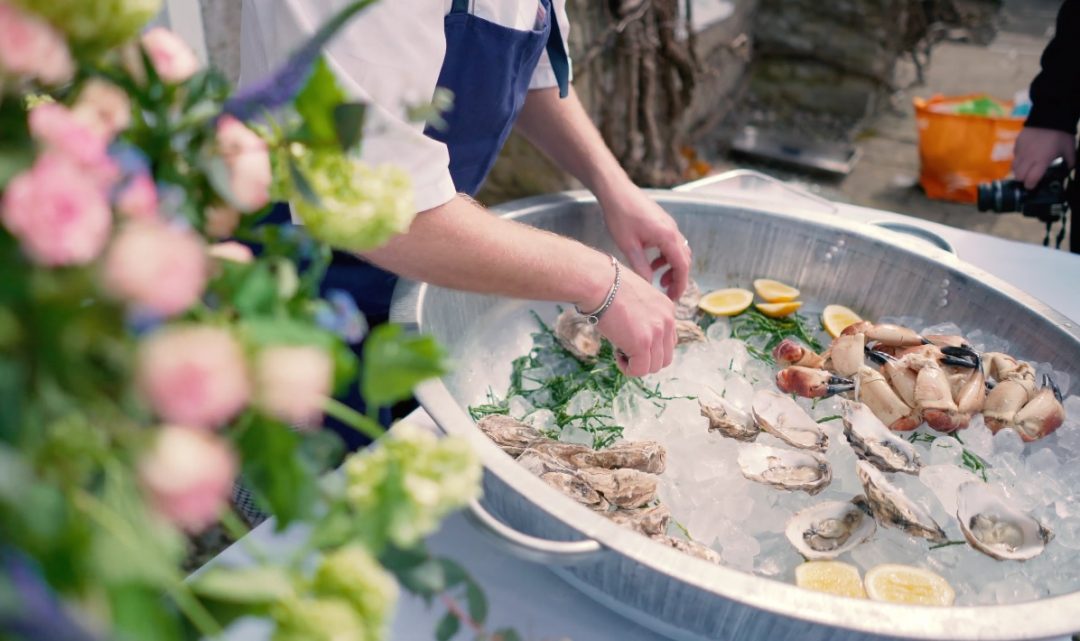
by Hanami Dream | 1, May, 2018 | blog, guest post, tips
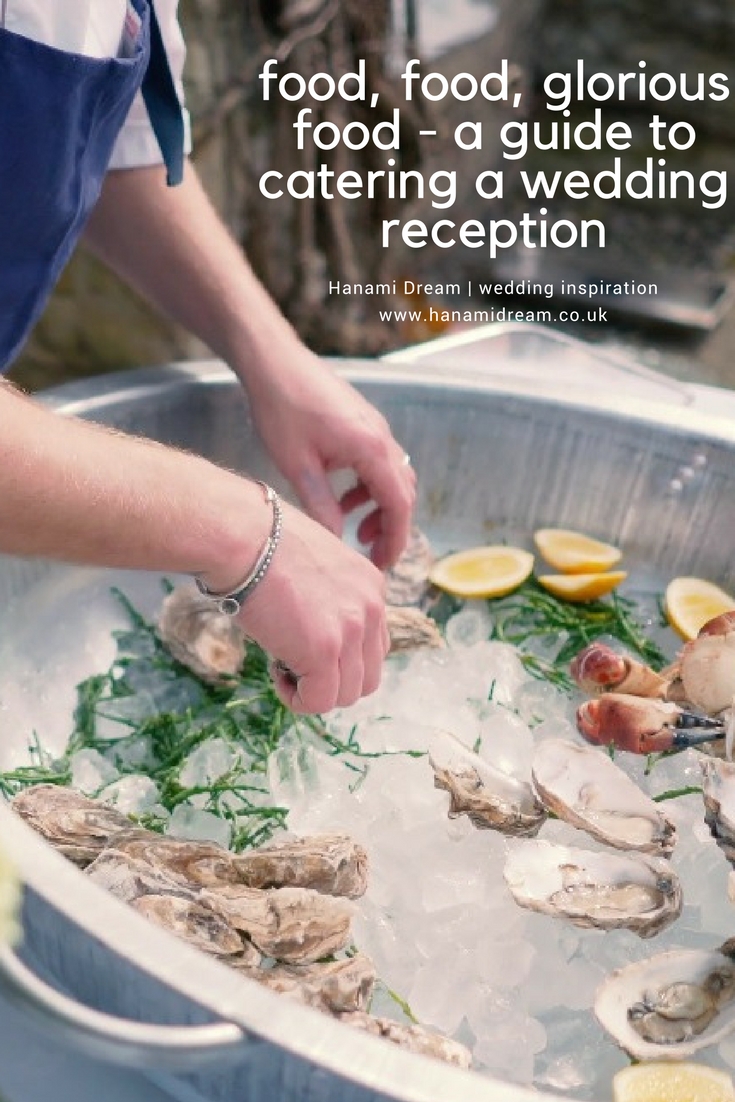 Food, food, glorious food – a guide to catering a wedding reception
Food, food, glorious food – a guide to catering a wedding reception
As mentioned, in the post ‘How to keep your wedding guests happy’, my number one top tip to keep your wedding guests happy (and ensure your wedding is remembered as a great day by all) is to keep your guests fed, watered and entertained.
If you get this right then you pretty much can’t go wrong by them. Fail at one of these things and your guests will get twitchy, tetchy or bored. Plus as someone with dietary requirements, I’m always impressed (& relieved) when different diets are considered at a wedding (take a look at my post on ‘Catering for special dietary requirements’).
Top tips from top caterers
Here are some tips from top local caterers Ross & Ross Food, who have been recently named ‘The Best Wedding Caterers in the UK’ in the Hitched Wedding Awards 2018. Here is their insight into catering your wedding reception and a look at current catering trends to consider in your wedding planning.
1) Food stations are a huge trend right now
Since we started wedding catering in 2015, we noticed a big spike in people’s love for food stations. Basically, they are small stations of different types of food that your guests can approach and select what they want.
The idea behind our food stations is that it creates a social aspect to your wedding. It also allows your guests to try a variety of different foods, instead of having a simple plated dish. Our food stations include Iberico Ham stations, Oyster stations, Doughnut walls and Yakitori stations.

2) Seasonal food is a must
At Ross & Ross Food we pride ourselves on quality and a bespoke service. We provide this excellent quality by always using seasonal food in our clients bespoke menus.
Using seasonal food ensures the produce is fresh and of excellent quality. This, therefore reflects in the standard of our food and evidently our clients are always blown away. We pride ourselves on the idea of supporting local, so always try to use local producers around the Cotswolds.
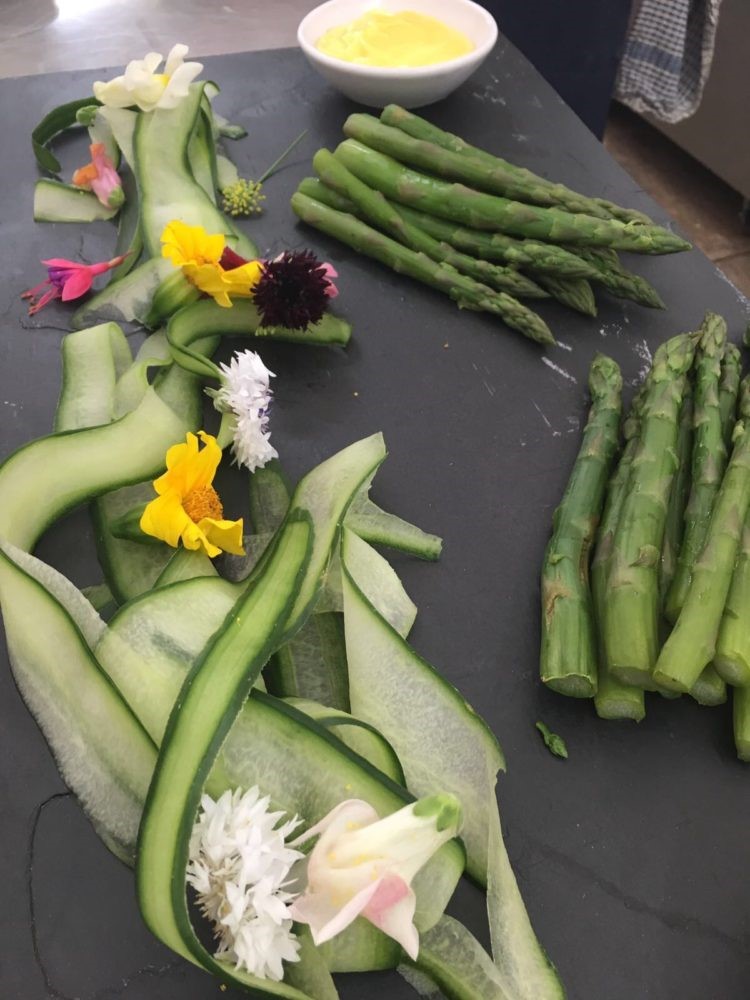
3) Sharing boards are great for socialising
Sharing boards are a great idea for your guests to connect and socialise, whilst tasting amazing food! Some of our sharing boards include: Our famous Scotch Eggs & Coleman’s Dressing; Hot Smoked Salmon; King Prawns & Lemon Mayonnaise and Cotswold Cured Meats.
Hopefully these will give you some ideas, if you are looking at the idea of sharing boards. They are also a great opportunity to try a variety of foods, instead of one traditional option.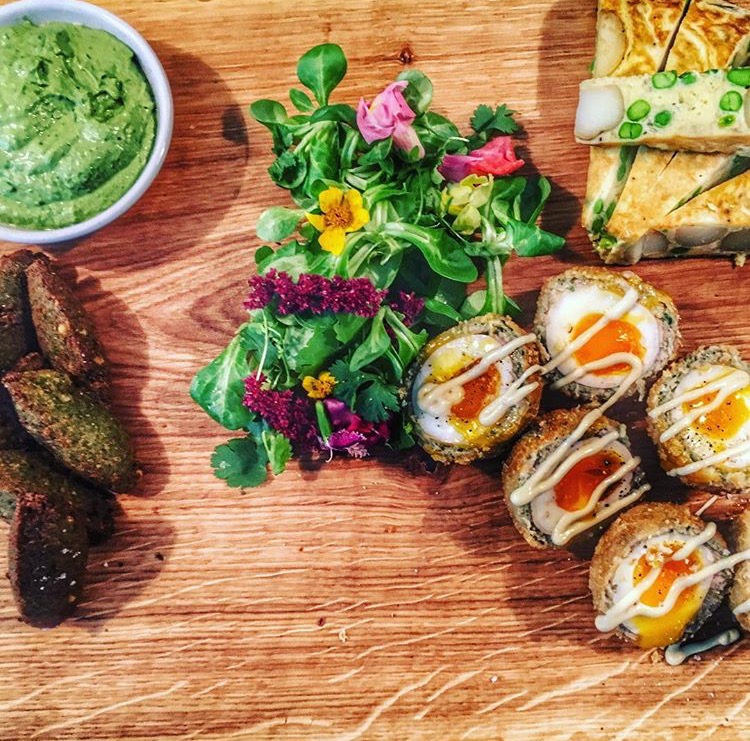
4) Trust in your suppliers
Once you’ve decided who is going to cater for your wedding, you must put your trust in them! You have chosen them for a reason, so you know they are going to a fantastic job.
We ensure there is regular communication with our clients to ensure they are happy at every stage of the process. All of our clients have had extremely positive things to say about our food and service which is why we are a trusted caterer. Once you have been through your ideas and requirements, just relax and leave the work to them.

 @rossandrossfood
@rossandrossfood
 @rossandrossfood and @rossandrossfoodevents
@rossandrossfood and @rossandrossfoodevents
 @rossandrossfood and @rossandrossfoodevents
@rossandrossfood and @rossandrossfoodevents
My tummy is rumbling just thinking about all this food! Bon appetite!
Sign up to receive the latest wedding planning tips, tools, trends and traditions straight to your inbox.
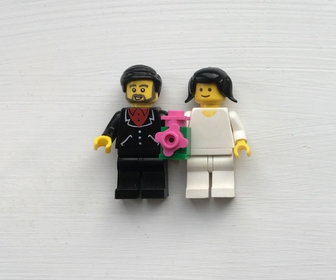
by Hanami Dream | 22, March, 2018 | blog, guest post, trends
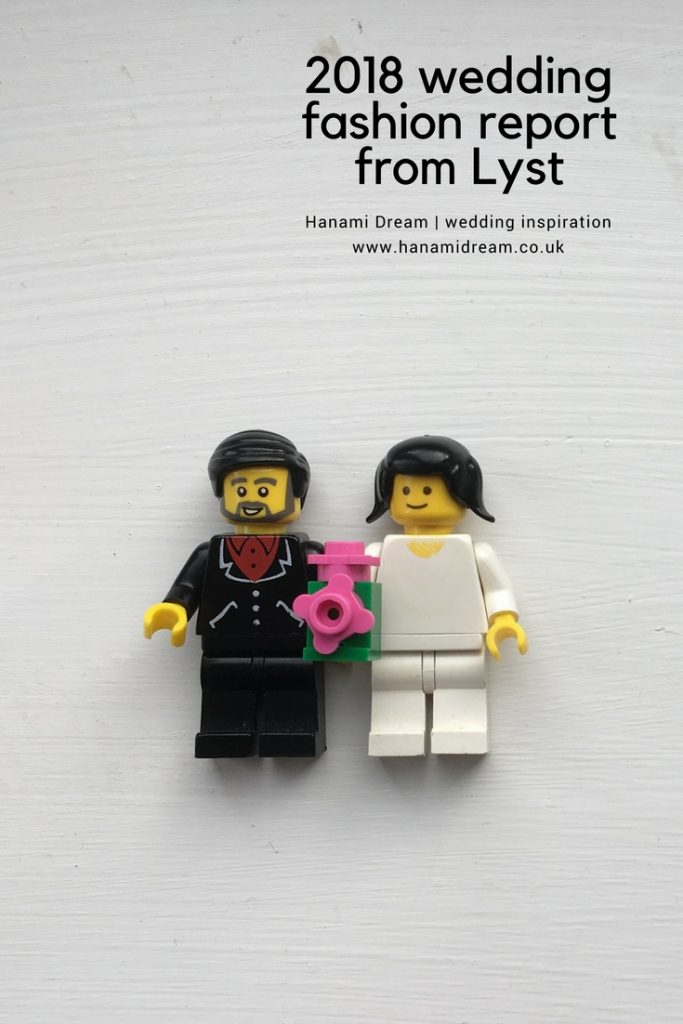
Absolutely delighted to share this year’s wedding fashion report from Lyst, a global fashion search platform where you can search thousands of online fashion stores at once, bringing together 5 million products from 12,000 of the world’s leading brands in one place. From emerging trends to worldwide fashion movements, Lyst is a unique source of global fashion intelligence.
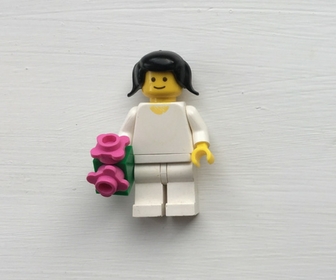
Analysing search and sales data across 12,000 online stores and designers, global fashion search platform Lyst has compiled these 5 key insights about how brides are shopping for wedding outfits online this year:
1. Brides are breaking from tradition in a year of female empowerment
- Searches for bridal jumpsuits and bridal suits have increased by 113% in the last year
- Searches for wedding dresses including the words ‘backless’, ‘sexy’ or ‘nude’ have doubled year on year
- But modest dresses are popular too; ‘long sleeve’ and ‘high neck’ styles have seen a combined 47% increase in views year on year
2. Wedding dresses are getting cheaper
- Last April the average price of a wedding dress on Lyst was £832, 25% lower than in 2016. This year it has decreased a further 5% and is currently £790
- Wedding dresses from Topshop, Coast and ASOS are the most wanted cheaper options, along with contemporary brands Needle and Thread and Reformation
3. The Meghan Effect is a big deal for bridal brands
- Brands that Meghan Markle could wear on her big day have seen significant increases in wedding dress searches; Erdem (+43%), Ralph & Russo (+82%), Misha Nonoo (+79%), Roland Mouret (+38%)
4. 2018’s weddings will be the most colourful yet
- Searches for coloured bridal dresses are becoming more popular. White is still the number one most wanted option, followed by rose, yellow and red
- Searches for ‘black bridal dresses’ have increased 18% year on year
5. 1920s bridal accessories are having a moment
- Sales of hair clips and headpieces have risen 39% in the last year. Simone Rocha is currently the most searched for brand
- Brides are five times more likely to opt for jewel encrusted or coloured shoes with their wedding dress than cream or white
- There are 24% more feathered bridal products on Lyst than this time last year

The Top 5 most influential celebrity weddings of the last year Lyst looked at spikes in search and sales of some of the last year’s most talked about celebrity weddings to analyse which brides really set the trends:
1. Pippa Middleton married James Matthews, 20th May 2017 (Wedding dress by Giles Deacon)
- Giles Deacon saw the largest spike in searches of any wedding dress designer, with search increasing 148% in May
2. Serena Williams married Alexis Ohanian, 16th November 2017 (Wedding dress by Sarah Burton for Alexander McQueen. Wedding dress 2 and 3 by Versace, with bejewelled Nike sneakers)
- Serena had 3 designer wedding dresses, but it was her bejewelled Nike Cortez sneakers that got the world talking; searches for Nike Cortez increased 8% that week
3. Emily Ratajkowski married Sebastian Bear-McClard, 23rd February 2018 (Suit by Zara)
- Searches for Zara suits increased 58% week on week following Emily’s super Instagrammable marriage to Sebastian Bear-McClard in February. Searches for mustard yellow across all categories also saw a boost
4. Miranda Kerr married Evan Spiegel, 27th May 2017 (Maria Grazia Chiuri for Dior)
- It was Miranda’s Stephen Jones headpiece that caught brides’ attention in Australia, prompting a 43% increase in AU searches for bridal headpieces
5. Chanel Iman married Sterling Shepard, 3 March 2018 (Zuhair Murad)
- The Victoria’s Secret model tied the knot earlier this month, and her embellished cape led to a 29% increase in demand for lace capelets in the US
See more at https://www.lyst.com/articles/2018-wedding-fashion-report/
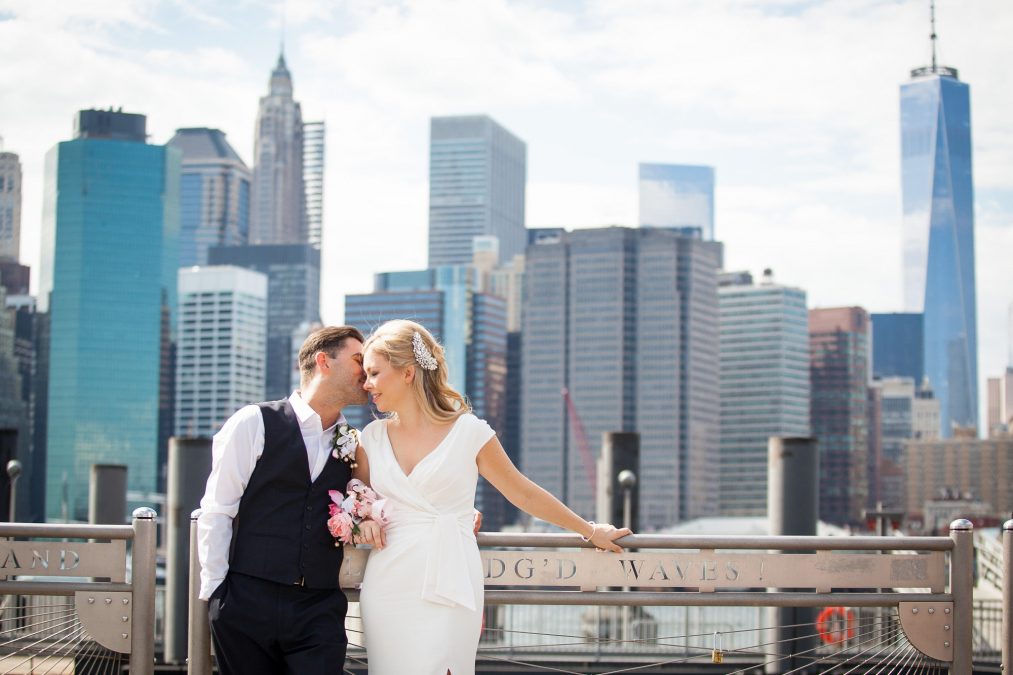
by Hanami Dream | 2, March, 2018 | blog, guest post, tips
Whilst we are very lucky to be surrounded by so many amazing wedding venues in the Cotswolds, there is always the allure and escapism of flying off somewhere else to tie the knot, perhaps to evade the stress and politics of wedding planning on your home turf.
Couples may chose to elope in secret (possibly behind their parents back) and sometimes in a hurry. However, elopement nowadays is less about running away and more about picking a romantic destination to get married with just a few of your close family and friends.
Here are some top tips from Claire at Wed in Central Park about planning your very own wedding abroad:
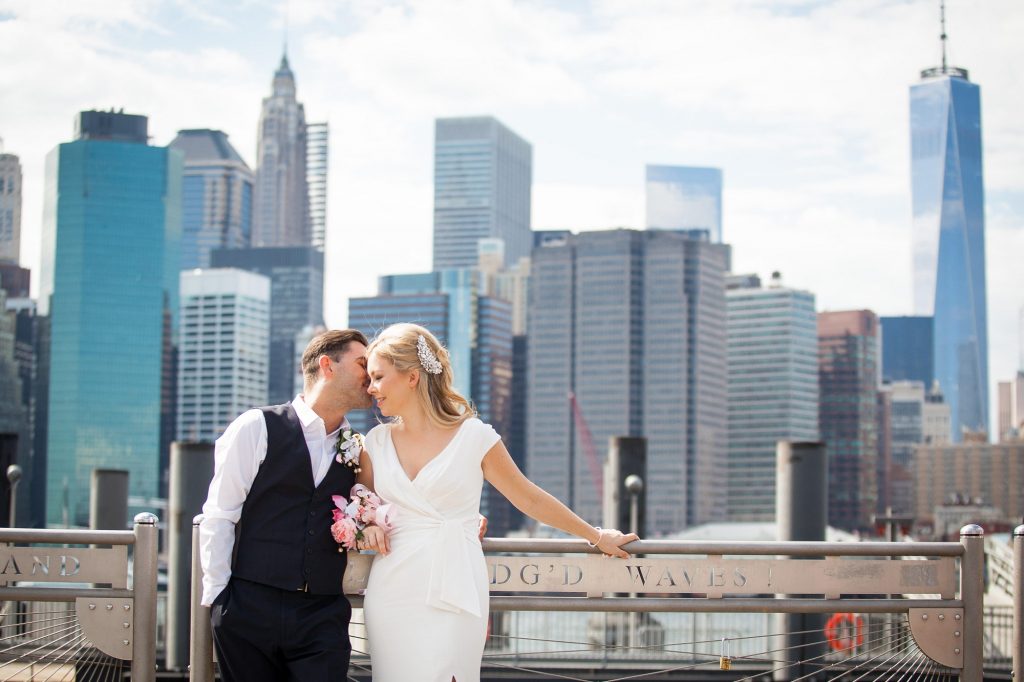
When many people hear the term “destination wedding” they think of a wedding ceremony taking place on a beach, somewhere sunny. Beach weddings are beautiful but they’re not for everyone, and many couples are considering eloping, or bringing a small group of their nearest and dearest to a city or countryside destination abroad for their special day.
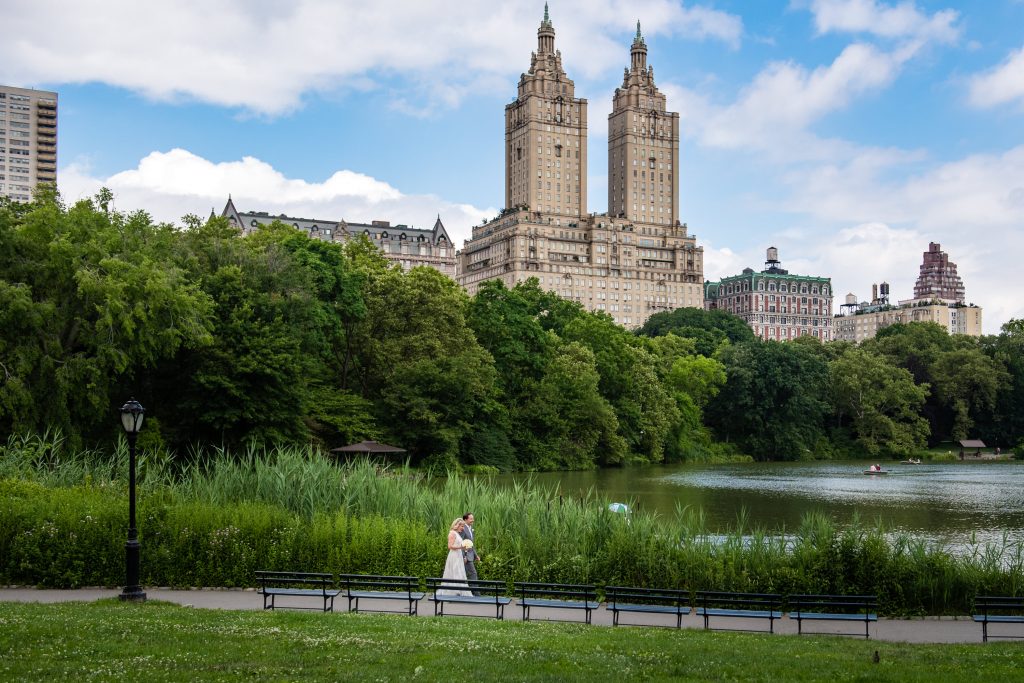
1.Paperwork
The first thing a couple should check when they start thinking about a particular location for their destination wedding, is whether they can legally marry in that country. Some countries require complicated paperwork, or for the couple to be in the country for a very long time before they can marry, and if you don’t speak the language things can get tricky, and for same-sex couples matters can be even more complicated. Often couples get around this by marrying close to their home for the legal part of their wedding, and then having the ceremony and celebration (and photos!) somewhere else.
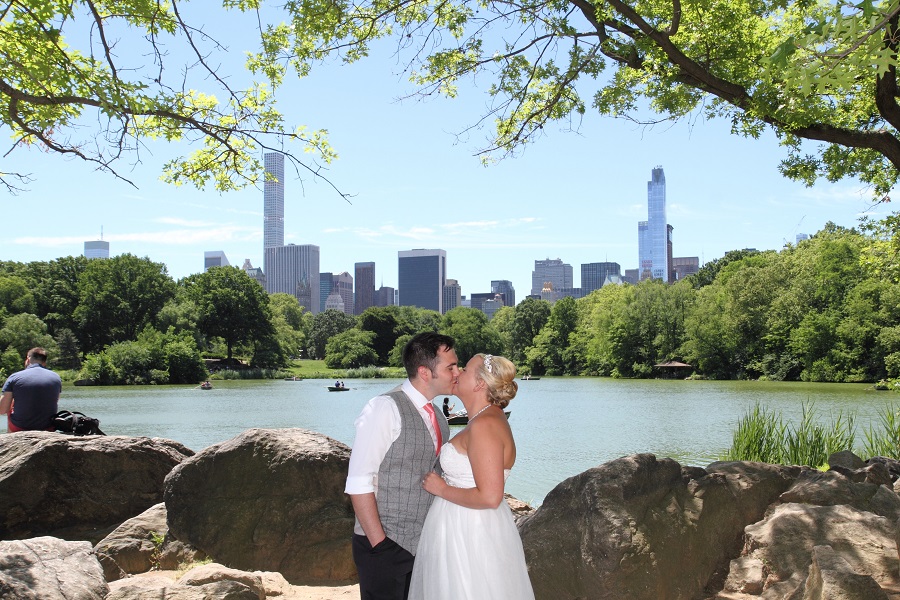
2.American Dream
Did you know that a wedding in the USA will be legally binding for British couples who live in the UK? So, there would be no need for marrying in a register office at home for the legal side of things, just one wedding (and one anniversary) each year! Perhaps the idea of marrying at the Grand Canyon appeals to you? Or in a forest on top of a hill in the Yosemite National Park? Or for that beach wedding in Hawaii or California? Or a big-budget Disney wedding? Or the ever-popular Vegas wedding? All of these locations would be fantastic in my opinion, although some easier than others to achieve. My personal favourite, and the area I specialise in, is helping couples to get married in New York’s Central Park, or indeed anywhere outdoors in New York. It’s my personal favourite because that’s where I got married!
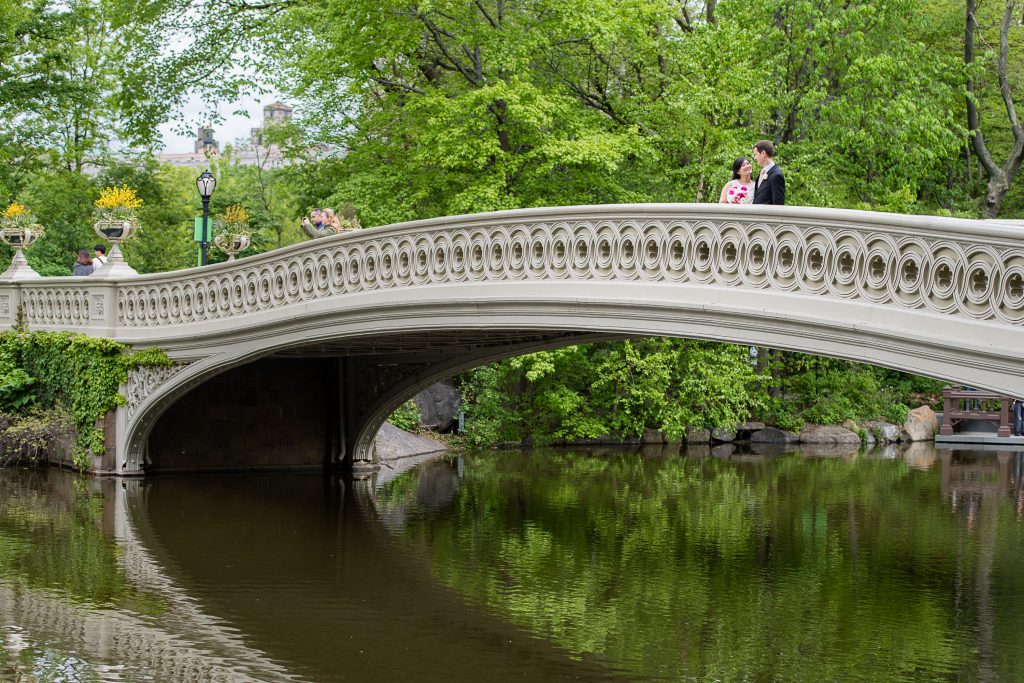
3.New York, New York
To get married in New York, all you need to do is go to City Hall in person, together, with your passports and a credit card to pay $35 with and pick up a license. Then you wait at least 24 hours and after that you can get married! I guide couples through all of the decisions needed to decide how to have the wedding of their dreams in this beautiful, iconic, world-famous oasis of calm in the centre of one of the world’s greatest and busiest cities. After a wedding ceremony in the stunningly beautiful Central Park, with the iconic backdrop of the skyscrapers behind the tress, couples can go all over the city taking photos – the Top of the Rock, Brooklyn Bridge, Times Square, Grand Central – there are so many places that will truly make your wedding photos unique. And then after that; a reception and celebration in one of New York’s incredible restaurants! There really is something for everyone in New York.
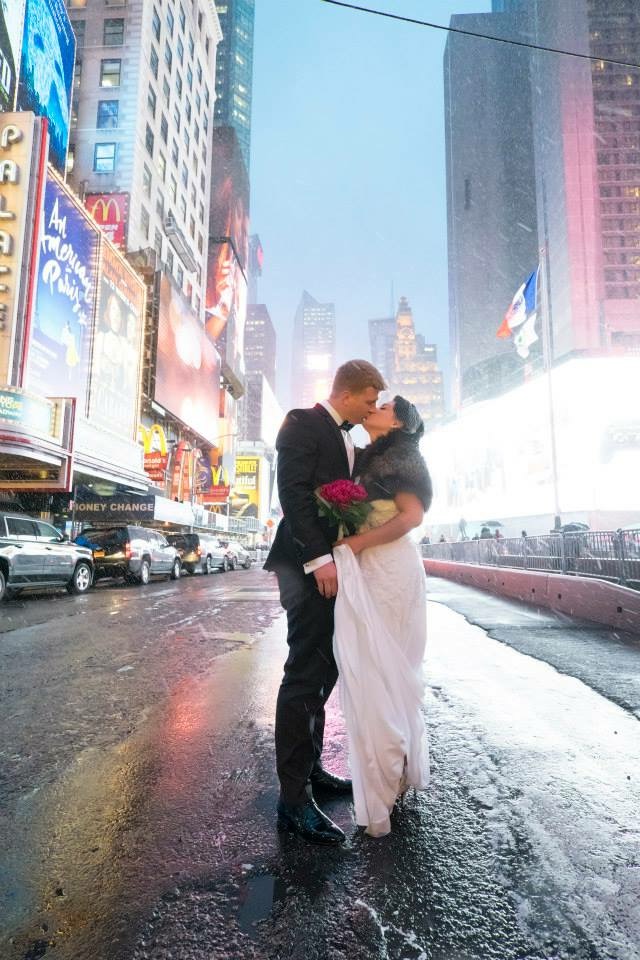
4.Who, where, when and how much
If you are considering a wedding abroad I would suggest that you consider what time of year you would be there, and who you would bring with you, if anyone. That will help you to work out a basic costing of the travel and accommodation, which are the major costs when it comes to a destination wedding. You might want to tag a honeymoon on to the trip after the wedding, somewhere close to the wedding location. Many of my clients plan on eloping and then, when they tell their loved ones what their plans are, their close family and friends want to come along too! I would always suggest discussions with your nearest and dearest, whether you are planning on inviting them or not. If they’re coming along, then you need to work out a good time for everyone. You will also need a plan for where everyone will stay and how long for – if you are marrying in New York, then some guests might come for a few days before or after the wedding day, or you might want everyone there at the same time, to allow for hen and stag outings while you are there. If you are eloping, then you might want to throw a big party on your return for wider friends and family, and perhaps keep to the theme of your wedding location.
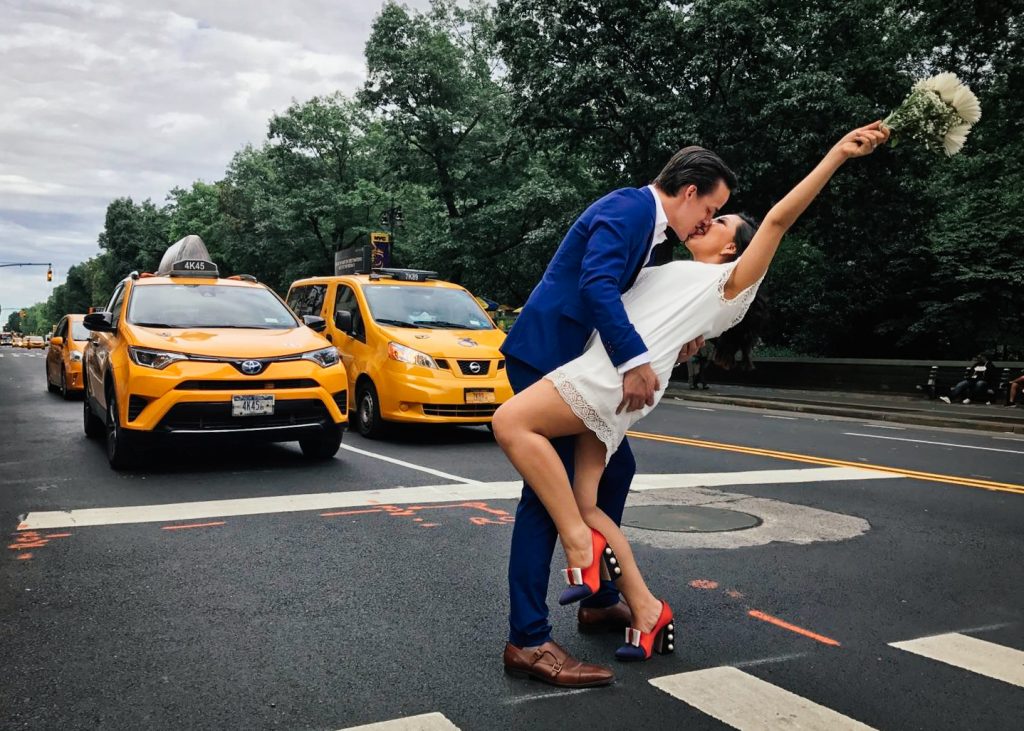

 @CentralParkWed
@CentralParkWed
 @centralparkweddingclaire
@centralparkweddingclaire
Sign up to receive the latest wedding planning tips, tools, trends and traditions straight to your inbox.
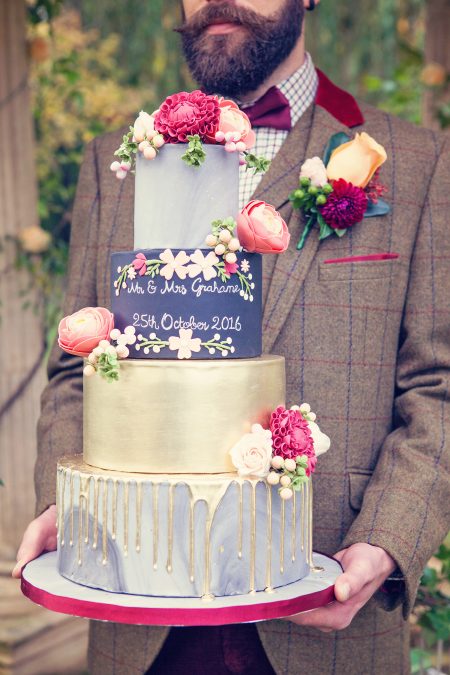
by Hanami Dream | 13, January, 2017 | blog, guest post, tips, traditions
A topic very close to my heart (and sweet tooth) is cake!
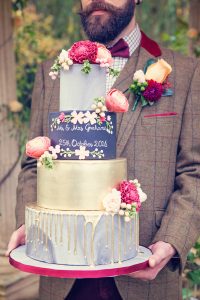
Photography by Farrow Photography
www.farrowphotography.com
When it comes to weddings, cakes are often the focal point of the wedding reception – proudly displayed, incorporating themes and colour schemes of the day, and featured in one of the main staged events of the day – culminating in a great photo opportunity when it formally gets cut.
There are many elements of a wedding that are steeped in tradition, superstition and symbolism. Here I unravel a little behind why wedding cakes are included in the festivities and then The Pretty Cake Company give their advice for the perfect ‘recipe’ to get the wedding cake of your dreams.
Even though some couples are picking alternatives to the humble wedding cake (such as ‘cheese’ cakes, cupcakes, giant porkpies, quiches tiers and pancake stacks to name a few), the evolution of this wedding element is nothing new as it’s seen many guises over the years including bread rolls and pie.
The custom originally dates back to Roman and Medieval times when bread would’ve been thrown at the bride. Thankfully this developed into the breaking of the bread over the head (symbolizing the bride losing her virginity).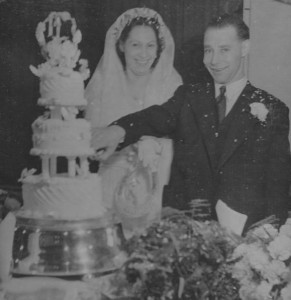
Over time this progressed into guests bringing baked goods to the wedding and piling them up as high as possible. The couple would try and kiss over this high cake without it falling over and were deemed to have good fortune if they were successful. Not content with the instability of a baked goods stack, one clever baker came up with the idea of sticking the rolls together and the Croquembouche was born.
Today’s traditional wedding cakes have a rich fruit cake (a sign of fertility), often a gorgeous layer of marzipan (that I can’t get enough of! ) and white fondant icing. The white colour of the bride’s cake was again a sign of purity and also one of wealth as fine white sugar would’ve been expensive back in the day. The whiter the cake the wealthier you were plus the number of tiers showed extravagance too (although often some tiers could be fake ones to save money!) Plus an alternative ‘darker’ groom’s cake alongside (perhaps in chocolate).
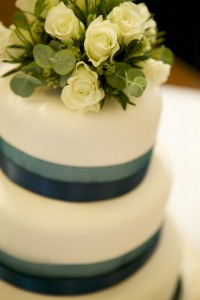
Photography by Farrow Photography
www.farrowphotography.com
Traditionally, the cutting of the cake (as well as being a staple photo opportunity) was done by the bride on her own (to symbolize losing her virginity) and she would hand out the cake to ensure fertility. Nowadays it is the first task performed together as a married couple. Some couples feed each other the first slice as a sign of commitment (or smash it in each others’ faces if you’re feeling cheeky!)
With the bottom tier for cutting, the middle tier for sharing, the top tier is often saved for the first anniversary or christening.
Meanwhile, symbolic charms placed in the cake attached to ribbons can be pulled out by the bridesmaids to predict their fortunes. Plus it was thought that single people who slept with a slice of the wedding cake under their pillow would dream of their future spouse.
There is so much tradition and choices to call upon to create your wedding cake and this element continues to evolve with emerging geode cut out cakes, crystalling detail, food walls and even wedding cakes with image projections on them. Take a look at some of my other trend predictions too.
Here are some top tips from the incredibly talented Samantha from The Pretty Cake Company with a cake designer’s insight into picking your cake and a look at current wedding cake trends to consider.
 The wedding cake will be the most prominent centrepiece of your wedding reception with the potential to be a highly decorative work of art. So deciding on what form your wedding cake should take, is one that should be given very careful consideration.
The wedding cake will be the most prominent centrepiece of your wedding reception with the potential to be a highly decorative work of art. So deciding on what form your wedding cake should take, is one that should be given very careful consideration.
An average wedding cake now is upwards of £500 and can go into the thousands, so your requirements will dictate your budget. The costing is primarily dependent on three things, size, flavour and decoration.
SIZE
When contacting cake designers it’s important to give as much information as possible. Give your anticipated guest number as this will allow the cake designer to work out what size tiers would be most appropriate. If you would like to reserve the top fruitcake tier for a first anniversary or christening then do mention that as well.
I have had clients in the past who want very tall grand wedding cakes, but not necessarily all the cake that would come with it, so think about the option of using polystyrene dummies to add extra tiers as this would help reduce the cost.
FLAVOUR
Simple sponges such as vanilla and lemon tend to be the cheapest with other most popular flavours such as chocolate, carrot and fruitcake, being more expensive due to the ingredients cost and increased time taken to make them.
Ask your cake designer what other flavours they could suggest as other flavours can often be made by adapting existing basic recipes. Other popular flavours that I have done in the past are coffee and walnut, orange and almond, lime and passion fruit, toffee and salted caramel, champagne and strawberry, but with lots of good quality flavouring extracts on the market, it’s very simple to come up with some more original suggestions.
Sometimes you can make a simple flavour more exciting by simply making the filling a bit more interesting, like lemon cake with a passionfruit curd buttercream or chocolate with a salted caramel buttercream.
DECORATION
Decoration is by far the most influential part of costing the cake as this is what takes the most time and requires the most skill. Things like sugar flowers, texture work and intricate pipework on the cake, can take several hours and sometimes days, so if you are on a budget, then maybe try and avoid these.
Here’s the ‘recipe’ to get the wedding cake of your dreams:
1. CONSULTATION
Check with your cake maker if they offer a face to face consultation, if there is a charge for it and whether cake samples would be available for tasting. It’s important that you have confidence in your cake maker and that the cakes will taste as good as they look. Some companies do charge for consultations, which might be deductible from the cost if you book.
2. EXPERIENCE
Most reputable cake makers will have a strong portfolio of their work which will be further substantiated with websites, social media pages and recommendations from previous clients and local venues. Do your research beforehand and choose a cake maker that has experience of the styles you like (such as elegant, pretty, floral wedding cakes versus novelty wedding cakes). Respect a cake maker who is honest with you and will tell you up front that they feel that there are better people out there who can create what you want.
3. AVAILABILITY
With weddings occurring almost any day of the week now, cake makers can be very much in demand. Ask your cake maker how many wedding cakes they take on in one week and how many people will work on it so that you know that your cake will not be compromised.
4. BOOK IN ADVANCE
I always advise my couples that once they have a date secured with their venue they should book, pay a deposit and reserve the date with their suppliers as soon as possible. Consultations and finer details can be worked out much nearer the time. Generally it’s best to book 9-12 months in advance. Often the cake is one of the first things you should book but one of the last things you should finalise as it can incorporate so many aspects of the wedding eg colours, flowers, fabric, stationery (which will only be known towards the end of the planning stage).
5. DEPOSIT
Ask when the deposit is required which tends to be between 25-50%. It’s always a good idea to make a note of when the balance is due to be paid. This tends to be between a month to 2 weeks before the wedding although check with your cake maker on their policies.
6. DIETARY REQUIREMENTS
Let your cake maker know if there are any allergies that they need to be aware of. However, also bear in mind that, unless you are using a very large company with allergy safe environments, it could be tricky to completely eliminate the risk of cross contamination.
7. ACCESSORIES
Think about how you want the cake displayed and how you’re going to cut it. A cake stand can dramatically change the way that a wedding cake looks and I always recommend the use of one. It adds precedence, height and is an added decorative feature. Most established cake makers will have a range of stands for hire. Some venues offer use of a cake stand as part of the package but always ask to see it beforehand, as they can be old fashioned silver stands which might not suit the style of your cake. It is generally the responsibility of the couple to return the stands within a couple of days of the wedding, unless this has been agreed prior and a collection charge has been paid.
8. DELIVERY
Make sure you let your cake maker know where and when the cake is to be delivered or if you are going to collect it. Most cake makers will charge for delivery and this will also include the return journey. They will also need to know who is the point of contact at the venue as you may be otherwise busy. Plus think about where the cake is to be set up, being mindful that it shouldn’t be in direct sunlight, or have a cluttered background.
Logistics aside, the fun part is picking what it’ll look like and how it will embody the theme of your special day. Here are some current trends in wedding cakes to give you some inspiration:
- Chalkboard: Chalkboards are often used at weddings for place settings, order of events and direction signs, so why not follow the theme through onto the cake, and personalising with a monogram or favourite quotes and lyrics. It’s also the perfect opportunity to show off some pretty calligraphy fonts.
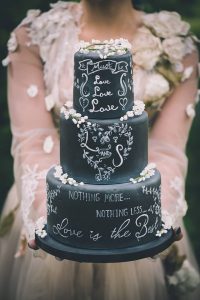
Photography by Neil Hanson
http://www.nordicpics.co.uk
- Semi naked cake: The naked cake has been around for a number of years now so it’s about time there was a new twist on it! The semi naked cake has a thin scraping of buttercream which allows the sponge to show through slightly. It gives an interesting rustic finish which looks beautiful decorated with fresh flowers and fruits.
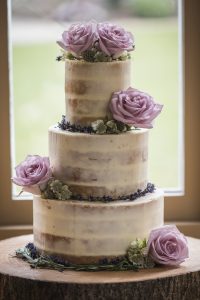
Photography by Neil Hanson www.nordicpics.co.uk
- Textured Buttercream: Lots of people love the thought of sinking their teeth into light fluffy sponge and a nice thick layer of delicious buttercream. So if you prefer buttercream to fondant then this is the perfect cake for you. Finished with fresh flowers, it gives an elegantly simple yet stylishly beautiful wedding cake.
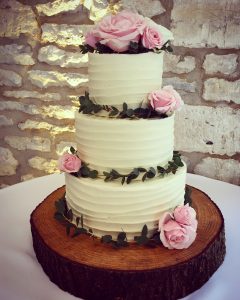
Photography by Pretty Cake Company
- Marble: Marble cakes are seeing a big revival at the moment and here is a cake which incorporates many on trend features. The marble tiers on the top and bottom are flecked with gold and the metallic drips on the bottom tier are also very fashionable. The chalkboard tier adds the opportunity for a bit of personalisation and the beautiful sugar flowers add a pretty feature which feminises the cake.
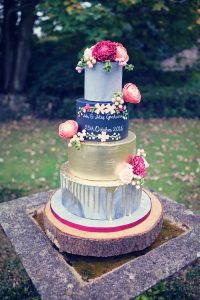
Photography by Farrow Photography
www.farrowphotography.com
- Ruffles/texture: Texture has been popular for a few years now and here is a cake which demonstrates texture in many ways. The vertical ruffles add an understated elegant texture; the gold sequins add sparkle and the pretty gold piping was inspired by a stationery design. Together with the sharp edge finish on this cake and the single garden rose on the top tier, this is a crisp, sleek and sophisticated wedding cake.
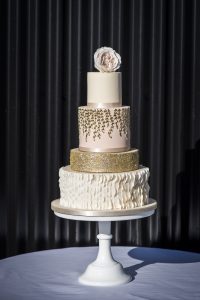
Photography by Neil Hanson www.nordicpics.co.uk
- Metallic and opulence: Metallic decoration can be seen in many ways, be it, metallic leaf, metallic lustre, metallic sequins or simple enhancements with a paintbrush and edible metallic paint. Here is a grand 5 tier cake with a metallic gold leaf tier. Metallic leaf can leave a distressed finish as it is very difficult to apply, but this is part of its charm. The cake was finished off with patches of intricate lace pipework and gorgeous sugar flowers.
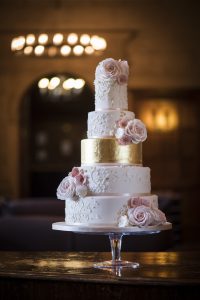
Photography by Neil Hanson www.nordicpics.co.uk
- Floral romance: Cake and flowers often go together, whether the flowers are real or if they are made from sugar. Here is a selection of recent floral wedding cakes showing how diverse each one can be.
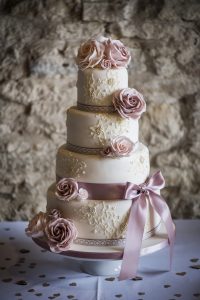
Photography by Neil Hanson www.nordicpics.co.uk
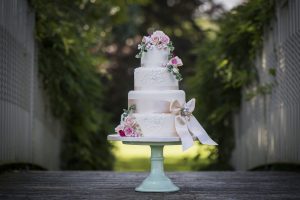
Photography by Neil Hanson www.nordicpics.co.uk
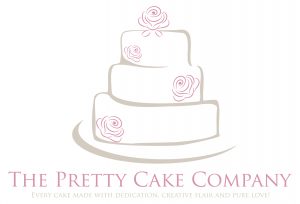
The Pretty Cake Company offers a friendly, personal and bespoke wedding cake design service to produce breath taking wedding cakes that will be remembered for years to come. They produce wedding cakes that are individual to the bride and groom – always focusing on the attention to detail that makes all the difference. They have over 10 years of experience in designing and creating wedding cakes and work closely with numerous prestigious wedding venues in Oxfordshire, Gloucestershire and The Cotswolds. They will work with you and take your ideas and inspirations in order to create a truly memorable wedding cake. They pride ourselves on using the finest quality and freshest ingredients available.
Unlike many other cake companies, they now specialise only in wedding cakes, as this is their true passion. Now they are able to focus on keeping up to date with current bridal trends and ensuring that their clients receive expert advice in the wedding cake field.
Clients are guaranteed a friendly, efficient service where quality is never compromised. Consultations by appointment only. They are based in Minster Lovell, Witney, West Oxfordshire and can deliver to a wide area.
 @Prettycakeco
@Prettycakeco
 @The-Pretty-Cake-Company-Witney-Oxfordshire
@The-Pretty-Cake-Company-Witney-Oxfordshire
 @theprettycakecompany
@theprettycakecompany
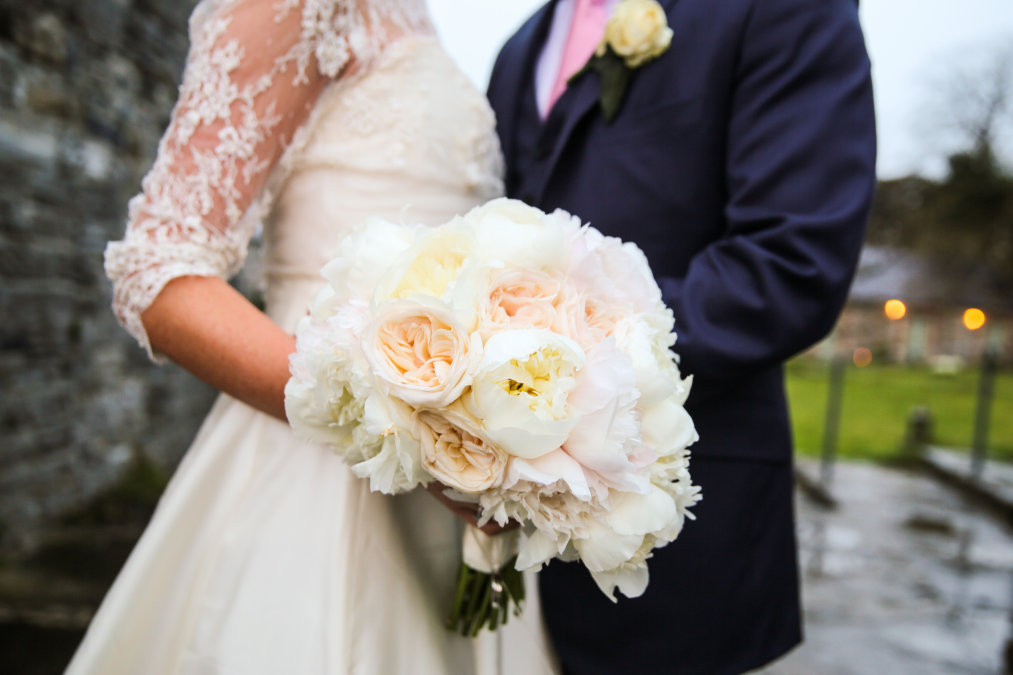
by Hanami Dream | 24, May, 2016 | blog, guest post, tips
The tradition of wedding flowers is steeped in symbolism and there’s lots to think about in terms of colours, meaning and seasonality.
Flowers have been a part of wedding traditions since at least Greek times when flowers would have been grouped together in a garland to be worn on the head and seen as a gift of nature. It would also contains strong smelling herbs such as garlic or chives to ward off evil spirits. In the Middle Ages, garlands were worn entwined with ears of wheat to symbolise fertility. And with the rarity of baths, the bouquets were a nice fragrant distraction from any other lingering smells!
Nowadays, wedding flowers can compliment and reflect the theme, style, colours, tone and surroundings of the day. You can include flowers in your bouquet, corsages, button holes, table decorations, flower walls, displays at venues or as confetti or petals sprinkled by the flower girls.
Flowers are a big focus in 2016 not only in the décor but with hair accessories and headwear. Plus a new trend of ring corsages is emerging and the use of wild flowers like daisies. It doesn’t all have to be about the flowers, as foliage will be as important or instead of flowers in displays. Alternatives to traditional flowers are seeing the use of succulents in bouquets, on tables and given away as favours. Plus instead of the usual confetti, there is now a herb toss as another option which gives such lovely aromas to this part of the day.
Then once you’ve finished with your bouquet (if you’ve not thrown it to your single friends), there’s also a lovely new trend emerging of the ‘lonely bouquet’ where you leave your bouquet in a public place, with a note for someone else to find – thus spreading smiles and the joy of flowers to others. (Google it, I’ve not made it up!)
We have asked the highly talented (and award winning) Dee McMeeking to help unravel some of the mysteries of picking the right flowers, at the right time of the year, for your special day.
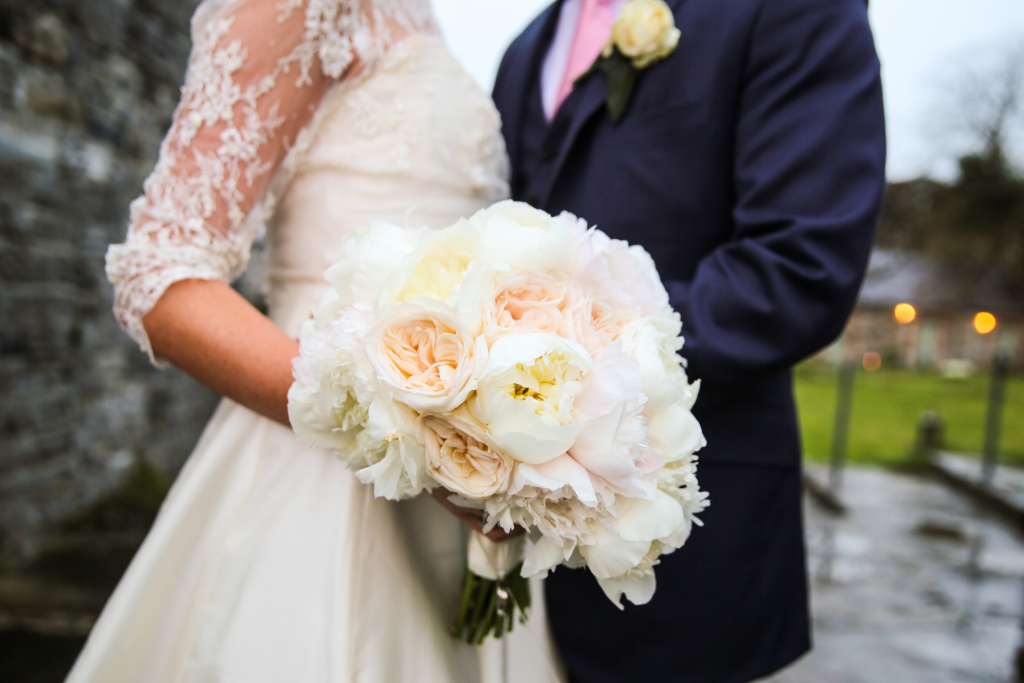
Photo credits: peony bouquet by Dee McMeeking, Photograph thanks to Nick O’Keeffe Photography
It’s one of those questions a bride to be will always be asked – “what flowers are you having?” and I know for some of you that can be a scary question! If you are blessed to know your hypericum berries from your viburnum then you will not need to read any further. But if your floral knowledge is more daffodils and dandelions then here is my quick guide to things you need to know about seasonal wedding flowers.
1) Flowers are seasonal
In theory that means that you can’t have certain flowers at certain times of the year. Think of it like Cadbury’s crème eggs or Easter Eggs – you don’t find them easily in shops in August or December! Flowers are the same. So if you have set your heart on a bouquet of peonies and you are getting married in the UK in November you may struggle. I say ‘may’ because the majority of cut flowers we use here in the UK are imported and most flowers are in season and being grown somewhere in the world, but that will make them more expensive.
Top tip: There are a couple of great apps that can help you out here – Flowerwheel, or Flowerbook. Both allow you to see when flowers are in season and more importantly photos and colours! So if your answer to the “what flowers” question is pink and white flowers, you can take this a step further and get some ideas with super search functions by colour.
2) Flower prices vary during the year
Flowers are one of those products where the prices will vary, sometimes quite significantly, at different times of the year. It’s as much about supply and demand as it is about seasonality. There is one big hot spot in the year that I have to mention – Valentine’s Day! The price of red and pink roses can treble if not quadruple just for that week. But other flowers can be cheaper than normal – such as orchids – purely because everyone is buying red roses.
When something is in season, it is naturally growing at its peak, the price is lower. So if you work with seasonal flowers you can get more for your money.
3) Using local flowers can save you money
More and more brides are opting for an informal look with their wedding flowers. The country garden “just picked” look where your flowers look more natural and less structured. If this is your style then you can do your own wedding flowers – certainly for your wedding reception, you might want a bit of help for bouquets and button holes. There are UK based growers who will sell you seasonal flowers “by the bucket” you just pre-order them, collect them, and then display them in your own personal style. Buying direct from the grower will save you some money and you will have very fresh flowers, often picked that day. To find your local suppliers check out this site http://www.flowersfromthefarm.co.uk/
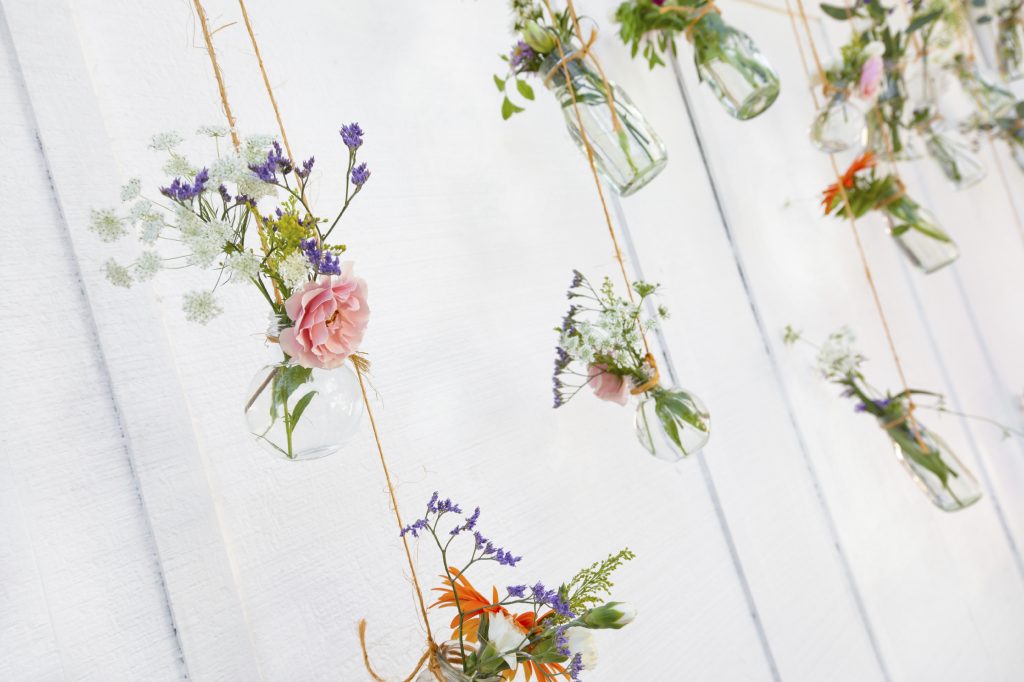
Photo credit: ©iStock/jesshorsenaround
4) The colours of flowers change with the seasons
I mention this purely from an experience I had with a bride who was fixed on her colour scheme of navy and gold and her flowers HAD to match to these colours. Now even at the peak of any floral growing season you are not going to get gold flowers and navy is also a tricky one too! Especially if you are in February in the UK! So if you are getting married in Spring or Winter remember that you may have to compromise with your flower choices. My solution was to go neutral with the flowers – ivory, white and creams and then add her gold and navy in through adding details such as ribbons and containers. Sometimes you may just need to be a little creative with your colour scheme.
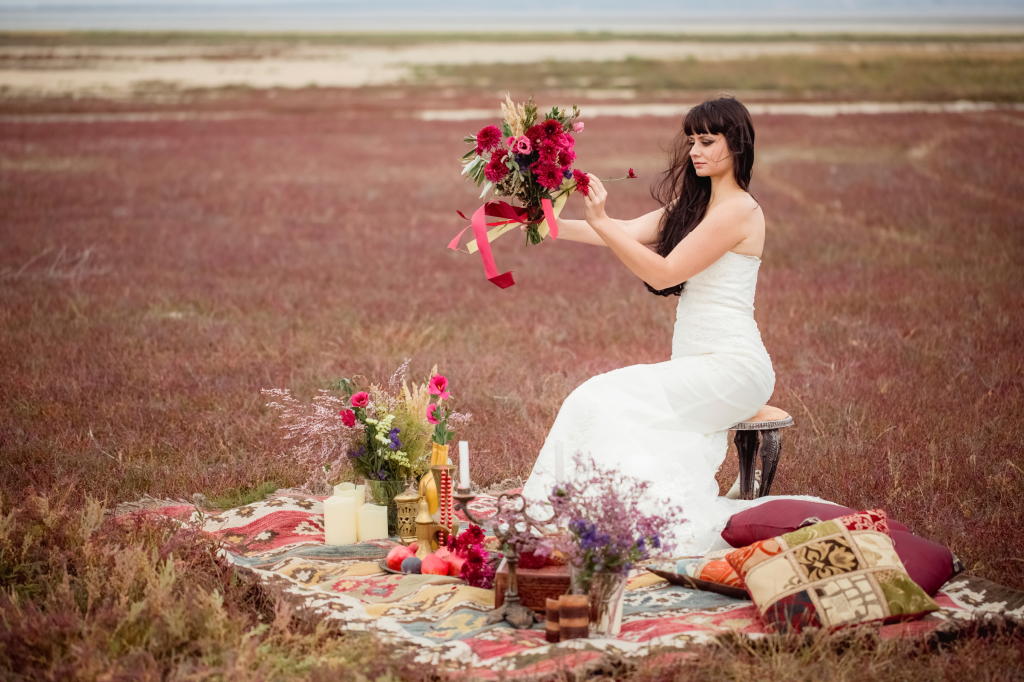
Photo credit: ©iStock/EvgenyBaranov
5) Where do I start with selecting my flowers?
Here is how I would approach finding out what is in season for my wedding flowers. First of all start with your wedding date and figure out which season you are getting married in. Search for “wedding flowers in season UK” now the UK bit is important because if you stumble on an American wedding blog in your search results what’s in season there may not be accurate for you! You will be surprised how many great guides there are already out there on blogs (just like this blog- check out these posts on seasonality, colours, and meaning of wedding flowers). Then I would pick out a few of these flowers that I liked and pop straight over to Pinterest and create a wedding flowers board. Search for “wedding flowers with xyz flowers” and see what emerges. When you have some visuals and you know roughly what is available at that time of the year you have enough research to either take to a florist or to source the flowers yourself!
Happy planning!
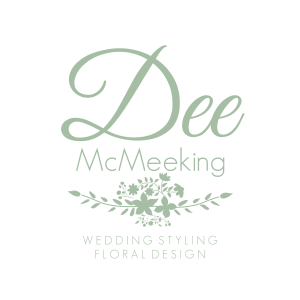
Dee McMeeking is the designer (wedding planner, wedding stylist & floral designer) behind Dee McMeeking Wedding Styling, a wedding styling & floral design business based in Warwickshire, UK & Dublin, Ireland. If you’re a creative with lots of great wedding ideas but need some help to bring your unique style to life on your wedding day, then contact Dee today at weddings@deemcmeeking.com. Dee works with clients from anywhere in the world and is waiting to hear more about your wedding styling ideas.

@deemcweddings

@deemcmeeking
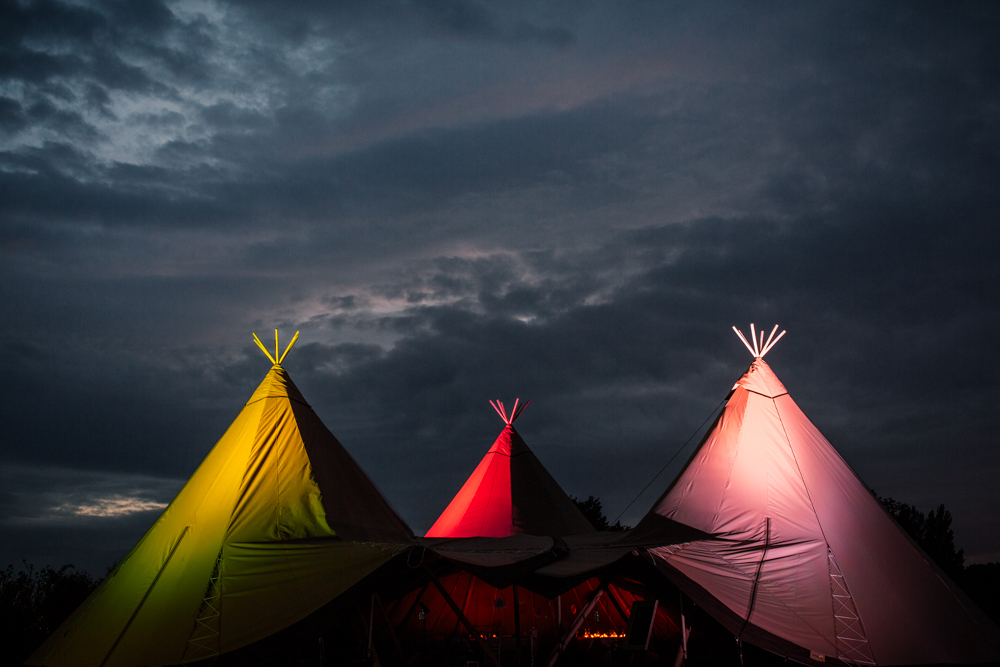
by Hanami Dream | 25, April, 2016 | blog, guest post, tips
For those couples who like to think outside of the ‘box’ (or building!) when it comes to picking a wedding venue, you may be interested in having somewhere that is a complete blank canvas (perhaps literally a canvas!). Somewhere unique and flexible so that you can decorate and lay out everything exactly how you want. A shell of a place that can cater to your very own style, be built around your theme and be set in the location of your dreams.
For a magical, sometimes intimate and truly romantic experience, many are choosing a marquee alternative to ensure a personal and unusual place to say ‘I do’. With current trends of festival and Coachella style weddings, people are looking for flexibility from the next generation of marquee style weddings.

No longer just a white tented box to offer, there are now numerous tented options to choose from including marquees, katas, yurts, sail cloth tents, circus tents, canopies, Chinese hats, pavilion tents and tipis. They each offer something a little different. For examples, marquees may not offer as much character as a tipi but wouldn’t have as many poles inside. So it depends what style you are going for and what you want the space to say and do for your big day.
At the moment, I am really loving the trend for tipis. The dictionary definition of a tipi/tepee/teepee is
a tent of the American Indians, made usually from animal skins laid on a conical frame of long poles and having an opening at the top for ventilation and a flap door.
For me, the fun, unique, and intimate, tipi-shaped structure is a space your guests will never forget. They can come in different sizes and can cater for large or small gatherings. For example a single tent would be better for a smaller gathering, or as a structure for a chill out area. Whilst a large gathering can be housed by linking tipis together to create a wonderful festival vibe space.
Putting together any marquee style wedding is certainly more work than going with a bespoke hotel package but the world really is your oyster when you have a blank page to start from and you’re only limited by your imagination! Here are my tips when planning a tipi wedding:
- Where to pitch your ‘tent’? Finding the right site is key to whether logistically your dreams can become a reality. Find out if the location has power (if not you’ll need to bring in a generator) and any other utility services (you’ll probably need to bring in toilets and the caterers will need to bring in water).
- How many guests are you inviting? If you have a number of guests in mind then you can start to decide how many tipis and the configuration that would work for your gathering.
- What time of year are you planning on tying the knot? If it’s going to be cold you may need to bring in heaters. If it’s likely to rain (and let’s face it, that’s always possible in the UK!) then you need to consider walk ways to avoid slippery grass areas.
- What do you want inside the ‘canvas’? Think about your floor plan and where you want the dance floor, bar and seating etc. Do you want long tables and benches or round tables with chairs? Everything you want inside the tipi, you need to think about and either buy, hire, make or borrow.
- What style or theme do you envisage? This will help you decide on décor and accessories (and where the fun begins on Pinterest!)
- How do you want the place lit? Lighting is vital for an outside venue, not only to create ambience and atmosphere but also to practically light the way when night falls (let’s face it, you don’t want to have a dark walk to the toilets in the middle of the night!)
- What style of catering do you require? If you want a hot sit down meal then you need to make your catering company aware of the venue location so they can factor in the equipment that they will need to bring with them. Or you may choose to go for a catering van that can just drive right up to the venue with everything ready onboard!
- Do your guests know about your location? It’s worth letting your guests know if you are getting married in ‘a field’ so they can wear appropriate footwear. Consider laying on special transport to get them to a remote location and maybe provide umbrellas and wellies on stand by if the weather is not favourable.

For more guidance on what to think about when planning a tipi wedding, we suggest speaking to the lovely folks at Love Tipis. Here’s their introduction to some of the services that they have to offer, kindly written by their Event Coordinator, Michelle Mockbee.
From themes of woodland fairytale to the wild west or for the festival bride, tipis give a new approach to hiring a marquee. In the world of weddings this caters to a couple that desires an unconventional and stunning approach to celebrate your big day. (Beyond weddings, tipi hire is becoming a more common choice for family celebrations, festivals, charity events, retreats and corporate events.) Tipis may give the impression of being casual, however this feeling of relaxation comes from a coordinated team with months, or in some cases over a year of planning.
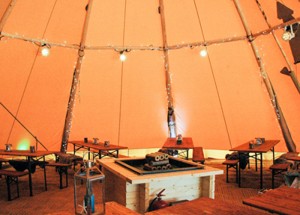
Tipis hired by Love Tipis originate in Sweden and are of substantial size, able to fit 12 Pine Wood Tables and Benches per tipi or a space for a concert and bar. The larger Giant Hat Tipis are 10.3m in diameter and link to other tipis. These tipis are also able to have the sides up, which gives the feeling of blending into the beauty of the natural environment. They also come with smaller tipis that link into the larger ones, allowing you to shape intimate tucked away spaces for a chill out or bar area. The number of seated guests determines how many tipis you will require. An average of 12 long tables with 8 to a table is able to fit per tipi, although this is a very tight fit. With round tables, the maximum you are able to fit per tipi is 7, which accommodates 10 people per table. Caterers will love you more if you hire long tables over round ones (they are easier to navigate).
There are other accompaniments such as a broad selection of LED lighting, indoor fire pits, bar, snug furniture and a dance area with a wooden dance floor. Some new additions at Love Tipis include some custom chill out or snug furniture featuring hand-stitched sheepskin cushions that settle in on apple crates. These seats serve as both luxurious seating and storage for your guests. They provide neutral tones to match any theme or colour scheme. Benches with cosy sheepskins have a lovely rustic feel, but your older family members, colleagues or friends might be giving you the evil eye all night and be quite uncomfortable. Remember you can always have a mix of chairs and benches.
Love Tipis work closely with clients to design the interior of the tipi from seating to fire pits. All the extra items you request takes up space. Exploring all the possibilities through floor plans, really allows the day to unfold before your eyes. The orientation/formation of the tipis, and how it all comes together allows for a stress free planning process. It’s their job to stress out over making sure everything fits, and they will walk you through the process so you can concentrate on the more important details, not the general logistics. They are also happy to come out for a site visit and walk you through the process. Your safety is their first concern.
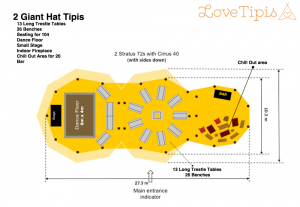
For events that will go throughout the night, lighting will leave your guests breathless. Beyond fairy lights, there are many considerations. The neutral tone of the canvass allows lights to create absolutely stunning effects. For example, it is not the disco ball that catches the eye, but the reflections and patterns it makes on the canvass. LED indoor uplighters can be set to multiple colours or hooked into the sound system to change with the beat of the music. LED outdoor uplighters create dramatic effects on both canvas or up in trees. Festoon lights are brilliant for pathways and setting the tone outside the tipis. All of the lighting is LED, which is very useful if your event is being run on a generator.
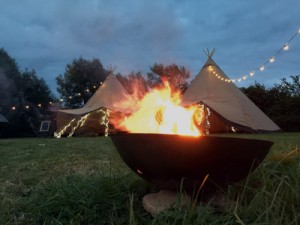
Tipis have smoke holes in the centre, and they hire out firepits to go inside the tipis. They also offer outdoor fire pits to cosy up to under the night sky. In regards to walkways, they provide flame torches or vases with slow burn candles. They also have a variety of candle chandeliers to hang inside the tipis in dining areas. All of these choices are based on your budget and your theme. Love Tipis make sure that the lighitng you pay for compliments the look your are setting out to achieve.
Love Tipis have developed special relationships with certain companies to provide all encompassing packages for clients that could include glamping, accommodation, license for marriage, as well as catering with bar and dining. They work closely with three companies that provide a variety of settings and themes depending on the ambience you seek.

The Maybush Wedding Company based in Oxfordshire is a pub on the Thames that provides an exclusive package to the pub with a field that hosts bell tents and two Giant Hat Tipis for your event. There are also options of accommodation nearby, along with a beautiful and quaint canal boat to be hired. For those of you seeking a mix between the outdoors and the facilities of a pub with catering, the Maybush is happy to make your dreams come true.

The Bell Tent Company based in Brighton provides all-inclusive packages with bell tents and tipis that host for any occasion. They are able to provide a variety of venues for those seeking a glamping, festival or woodland feel. Their sites provide bell tents, luxury loos, hot showers and a real ale bar with signature cocktails. Depending on your menu preference, there are options of hiring in a wood fired pizza boxcar or Mexican style cuisine. To get away from it all for a natural and relaxed feel in a field or in the woods with bell tents, food and a warm fire, this is the company for your event.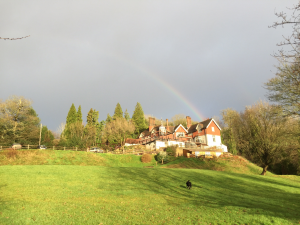
The Beacon is an idyllic rural setting with 17 acres and three ponds nestled in the woodlands of Tunbridge Wells. The newly revamped pub is at the top of a hill overlooking small villages and lush rolling hills. Their all-inclusive package is where luxury meets the wild west. This venue is licensed for marriage ceremonies and offers a variety of options to host up to 100 guests for a Love Tipis reception overlooking the natural beauty of the ponds and woodlands. The Beacon is part of the local food movement offering a gorgeous menu, and a top-notch service. For those of you looking for that luxury feel, whilst still being surrounded by the countryside, The Beacon is a gorgeous option. Take a look at their wedding pack for more information.

Love Tipis are based in Oxford and Brighton, which lends flexibility in hiring with Love Tipis. Each venue sets a certain tone and aesthetic. The tipis are able to offer numerous styles that provide a standard of event that compares to no other. With a vast knowledge and experienced team that loves the product they provide. At Love Tipis they pride themselves in providing a high quality service to work individually with their clients and their venues. By providing custom floor plans, lighting and seating layouts of the tipis, they strive for a stress free process that is thorough and prompt.
For more information go to www.lovetipis.co.uk or contact info@lovetipis.co.uk or call the Oxford Office on +44 (0)1865 250027 or the Brighton Office +44 (0)1273 689891.
 @LoveTipis
@LoveTipis
 @Love-Tipis
@Love-Tipis
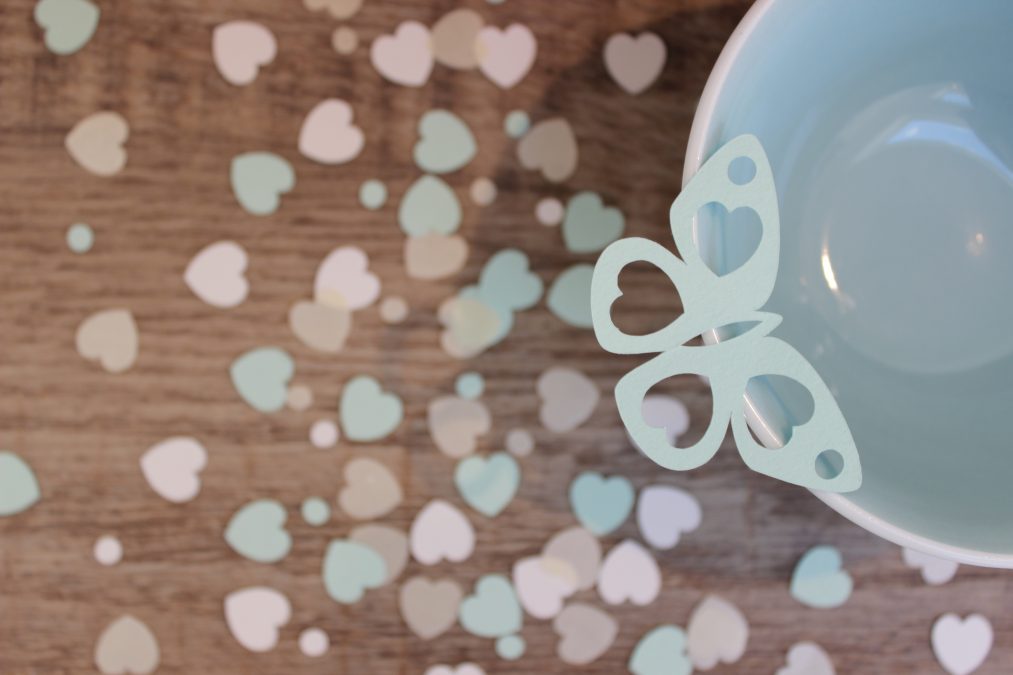
by Hanami Dream | 15, January, 2016 | blog, guest post, tips
According to the infamous shampoo advert, you never get a second chance to make a first impression. Whilst you have been living and breathing all things to do with your wedding, the first time your guests have any idea about your big day is when your wedding invitation or save the date card lands on their doormat.
This important piece of mail will set the tone, theme and your guests’ expectations of your special occasion. What you say, when you send it, to whom you address it and what it looks like all provide the first experience your guests have of your wedding. So it’s really important that you pick your stationery wisely to make the best first impression.
Look out for a forthcoming post on the wording of your stationery. Meanwhile, focusing on what it looks like and to help you wade through the sea of stationery, the hugely talented Suzanne from Paper Tree Design has put together this guide to help you find the right stationery for your budget.
You have set a date and secured your venue so your mind turns to stationery, where to start? The options are endless and mind boggling, and when you are surfing stationery sites from the sofa sometimes it is difficult to understand why pricing can be so different between suppliers. When you are choosing your venue there are things to help you with this, star ratings, facilities and services, but when it comes to stationery the differences in service, technique and embellishments are what makes your stationery either basic or premium.
The Service
There are 4 levels of service in stationery that will effect the pricing, Off the shelf, semi-customised, customised, and bespoke, in short, the more time the stationer spends on making your stationery, the more it will cost:
1. Off the shelf –This is the cheapest option and is exactly as it sounds! You purchase a pack of pre-printed generic wedding cards for you to fill in the date, location and guest name. These are the cheapest because the supplier gets thousands printed at a time and there is no extra art working for the supplier to do.
2. Semi customised – This is where you choose an existing design from a supplier and they place your copy in to the invitation (venue, time and date etc.)
3. Customised – A customised design is where you have the option to personalise an existing design to fit in with your theme. This can include changing colours, having your initials added in to the design, and having a choice of card types or trims etc.
4. Bespoke – If you have a specific idea in mind for your stationery and you cannot find an existing design to reflect this, then bespoke is for you. You will work closely with the designer who will design something around your theme ideas. This is at the premium end of the stationery market because you are paying for a designer’s time to create something for you. If you are considering this option then it is wise to allow at least a month for a design to be fully approved and ready for production.

The Product Quality
There are all sorts of card available for use in stationery in different weights (thickness), textures, and finishes, the thicker the card the more it costs, as it will any with specialist finishes and textures. The weight of card used can be the difference between an invitation looking ordinary or luxury so when you are comparing prices have a good look at what is being used, if it is not stated on the website then ask.

When you start reading the information on a stationer’s website you will come across all sorts of terms, litho pint, digital print, letterpress, embossing, hot foiling, laser cut, paper cut, duplexed, spot varnish. What do they all mean?
Printing – Printing on a invitation is more likely to be digitally printed these days as digital is suited to smaller quantities. Litho requires the making of a printing plate which makes small quantities much more expensive. A printed card on a standard board with no extra finishes or embellishments will always be the cheapest option. It is worth remembering that digital printing may not be suitable for some of the specialist papers.
Letterpress Printing – Letterpress is a traditional printing technique which involves inking a plate (printers tray filled with raised blocks) and pressing in on to the card stock, which leaves a deep impression. These days there are more hi-tech ways of making the printing plate but the process is the same. For small quantities it can be expensive but if you have a large number of guests it is more affordable.
Finishes
There are all sorts of lovely finishes that can turn a standard invitation in to something a bit more special, but bear in mind that for every finish you add cost. Below is a list of a few terms and what they mean:
1. Hot foiling – This adds metallic areas to the design.
2. Spot varnish – This adds a shiny or mat surface to areas of the design.
3. Embossing/ debossing – This adds texture to the card, either raised (embossed) or pressed in to the card (debossed).
4. Duplexing – If a card is duplexed, it means it is made up of two different boards sandwiched together of different colour or texture.
Laser cut, die cut, paper cut
The process of cutting out shapes or patterns from card (or other materials), the main difference being if it is laser cut then the gaps in the design are burnt out with the laser, if it is described as die/machine/ paper cut then it is cut out using a tiny blade. Cut invitations are usually made up of 2 or 3 layers (the cut, an inlay card & printed insert) which makes for a more luxury product.
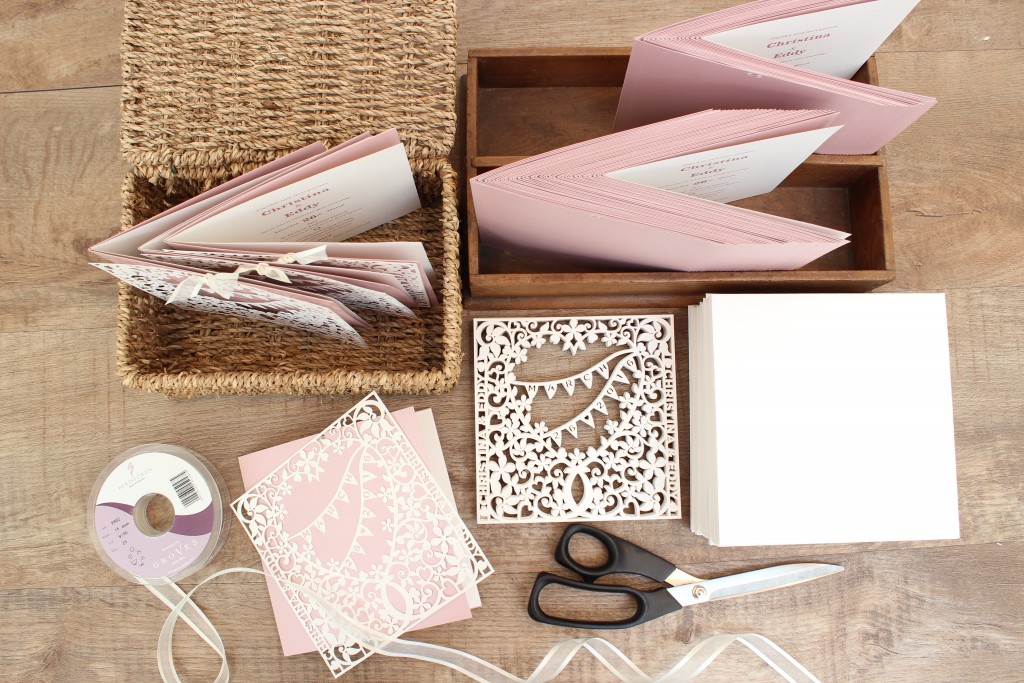
Trims
The use of ribbon, baker twine, crystals and other trims to finish off your stationery can really help to make it look special, but beware when you are looking at and comparing prices between stationers. You may see a beautiful photo of your chosen stationery suite tied together with twine and finished with a gift tag or other embellishments, and the costs look in budget, however some stationers charge separately for these extra finishings and you can find yourself paying £1.00 or £2.00 more per invitation than you had budgeted for, for the invitation in the picture. Anything that has any element of hand finishing adds time and therefore cost to the stationery, so check the small print!
Top tips
1. Help yourself – If you are really struggling for budget enquire about what could be provided in kit form in order to save on price.
2. Buy in bulk – Think about all your stationery in one go from the outset (invites, order of service, name cards, table numbers, menus, table plans etc) rather than separate pieces at different times. You can save if you buy ‘before the day’ and ‘on the day’ stationery all from the same supplier.
3. Compare the quality – Read the descriptions carefully and make a list of the differences in a notebook together with the prices, so you don’t forget when you start comparing price.
4. Beware the hidden extras – Double check the price list and ask if it is not clear.
5. It never harms to ask – If you have your heart set on something but you are worried it is out of your budget, then just ask if it can be modified to help with the price.
For more information go to www.papertreedesign.co.uk or contact suzanne@papertreedesign.co.uk


@PaperTreeOxon
@PaperTreeOxon
Paper Tree Design
 @PaperTreeOxon
@PaperTreeOxon
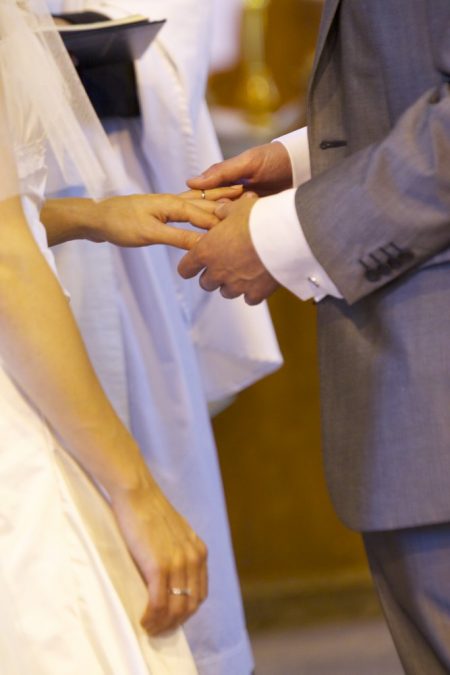
by Hanami Dream | 11, November, 2015 | blog, guest post, tips
We don’t have a television at the moment. After some building work before the summer we moved it and have never reinstated it. We haven’t missed it at all and what it has meant is that we only watch something that we really want to watch now (rather than flicking through channels if we are tired) or do other things instead.
I’ve taken to watching iPlayer whilst I cook and found some great period dramas over the summer to watch such as The Duchess of Devonshire, The Scandalous Lady W and Lady Chatterley’s Lover. I soon discovered that there’s a common thread through these and realised that all of these films made me feel really lucky to be a wife of this century. Plus along with the recent film release of Suffragette, I’m very grateful that I have choices and rights that my ancestors wouldn’t have had.
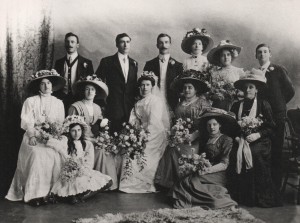
The vows I chose to make when I got married were promises rather than laws. I didn’t become the property of my husband and I chose not to ‘obey’ him in my vows. However a few centuries ago people didn’t have this same luxury. We live in a time when marriage is about partnership, lifelong companionship and equal rights.
The wording of the Church of England traditional wedding vows includes the bride promising to ‘obey’ and the groom vowing to ‘worship’ his wife. However some couples choose to leave out these words nowadays and alternatively choose ‘to love and to honour’ or ‘love and cherish’.
Traditional vows
‘I, (name), take you, (name)
to be my wife/husband,
to have and to hold
from this day forward;
for better, for worse,
for richer, for poorer,
in sickness and in health,
to love and to cherish,
till death us do part’
Traditional promises
Will you love her, comfort her, honour and protect her,
and, forsaking all others,
be faithful to her as long as you both shall live?
Whilst traditional vows still hold a lot of meaning, relevance and importance, we are also able to choose to make those vows more personal depending on the type of ceremony. Especially in humanist or non-religious ceremonies where you can personalise and express yourself completely when writing your own vows. Whilst sometimes the amount of choices we have in life can be overwhelming, I remain grateful that we have choices.
Over the past four years, Zena Birch has worked very closely with couples to help them create their own personal vows to go alongside or precede more traditional ring vows. Here are some of her top tips for writing your own vows.
In a humanist ceremony instead of holding themselves accountable to a god or a deity, couples are actually asking those gathered to hold them accountable as they witness their public declarations. Therefore the words they say as they make their vows and their promises to each other are more important than ever.
In today’s age it is possible to live very happily together without getting married, so when a couple decide to take this extra step it is a deeply personal commitment. Your vows are to be celebrated every year you manage to uphold them, but they should also be the words that hold you fast when times get difficult and as such it is important that the vows you say to each other are made up of the values and commitments you are willing to stand by.
My couples and I work together to discover just what those words/promises might be. It can be very daunting – faced with a blank page and some of the most important words you are ever going to say, so the advice I tend to give is to make sure they:
- sound like you, they should have your tone of voice, they should be authentic – if you tease each other, there is no harm in an element of this being reflected within your vows, this is just as important as a sense of solemnity. Capturing the twinkle in your eye as well as the sincerity in your heart is key.
- reflect what you have both agreed to commit to one another. Although many couples decide to say their vows as a surprise to each other on the day, it is important that the process involved in creating them is shared so that they are in agreement with their core values.
- Enjoy creating them!
We are lucky to live in an era where our own words hold validity. Writing your own wedding vows is a very enriching experience and one which can really help lay the foundations needed for a long and joy filled marriage.
For more information on a humanist ceremony go to www.zenabirch.com or contact zenabirchweddings@gmail.com

@humanistwedding

Zena-Birch-Bespoke-Humanist-Ceremonies

zenabirchweddings


 Ten things to remember when (not if!) you get stressed while planning your wedding
Ten things to remember when (not if!) you get stressed while planning your wedding![]()





 Overseas wedding insurance
Overseas wedding insurance

 Food, food, glorious food – a guide to catering a wedding reception
Food, food, glorious food – a guide to catering a wedding reception



















 The wedding cake will be the most prominent centrepiece of your wedding reception with the potential to be a highly decorative work of art. So deciding on what form your wedding cake should take, is one that should be given very careful consideration.
The wedding cake will be the most prominent centrepiece of your wedding reception with the potential to be a highly decorative work of art. So deciding on what form your wedding cake should take, is one that should be given very careful consideration.
























